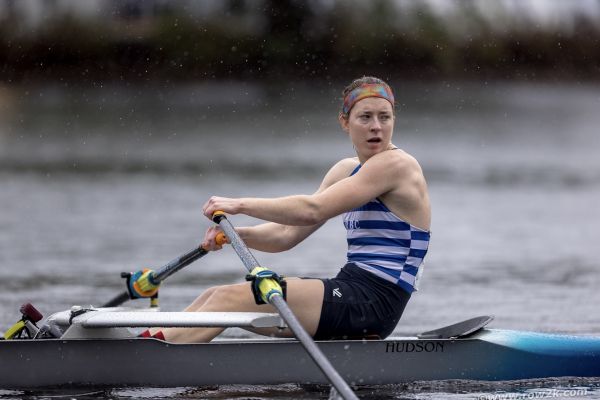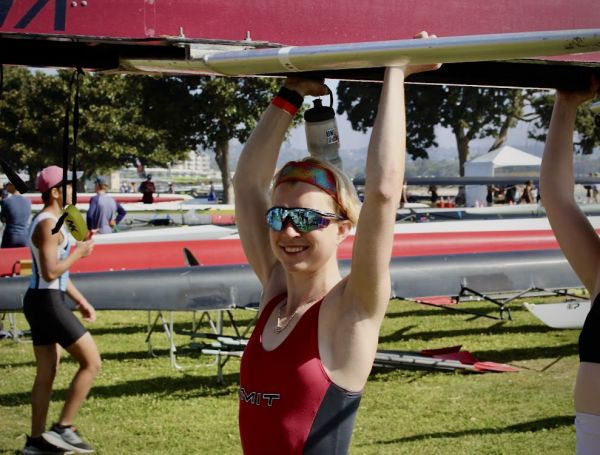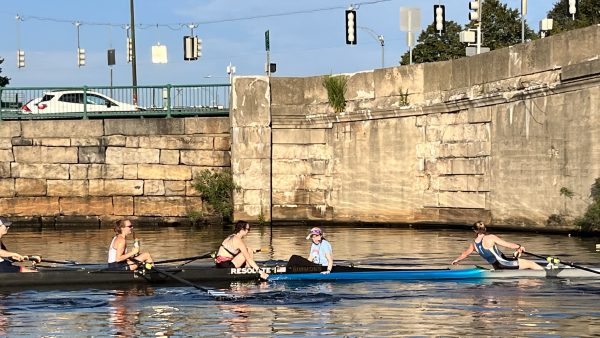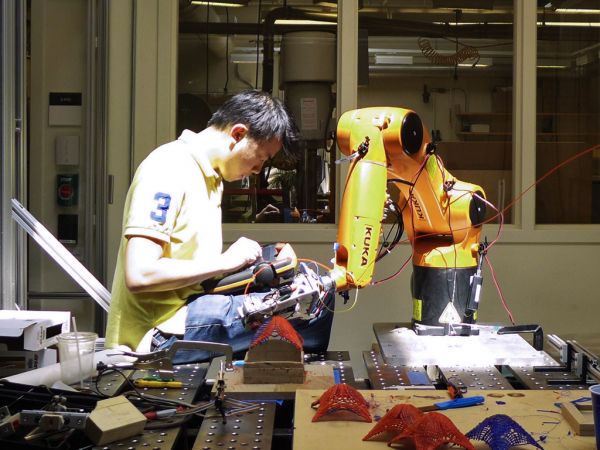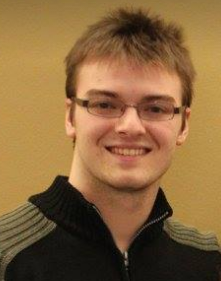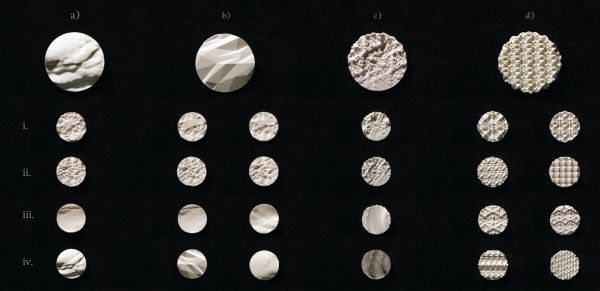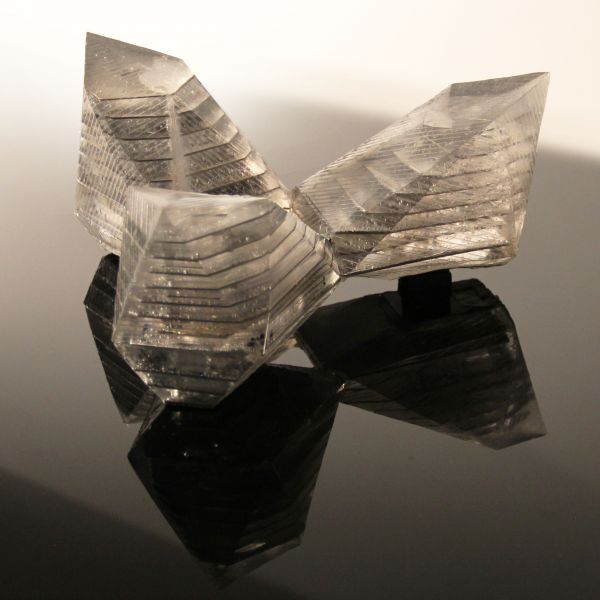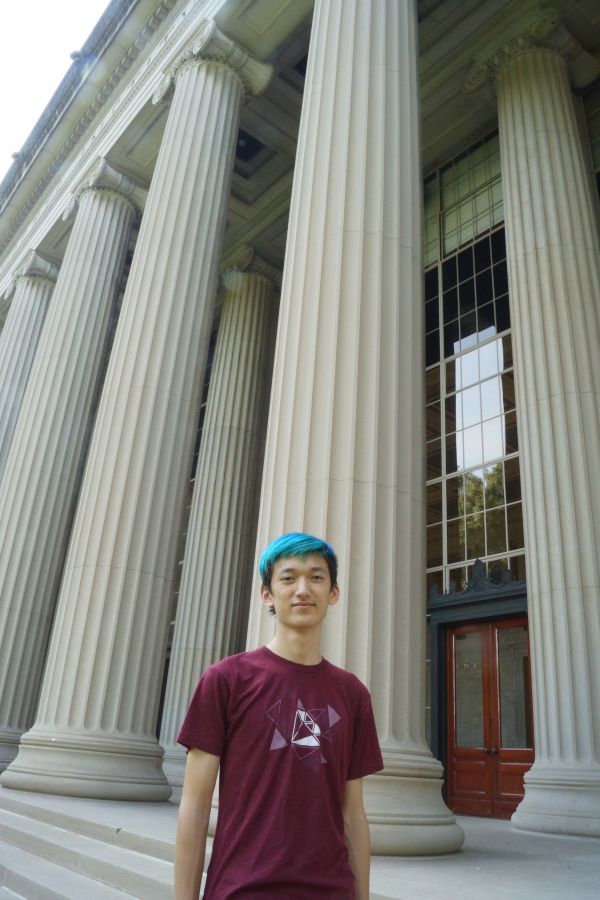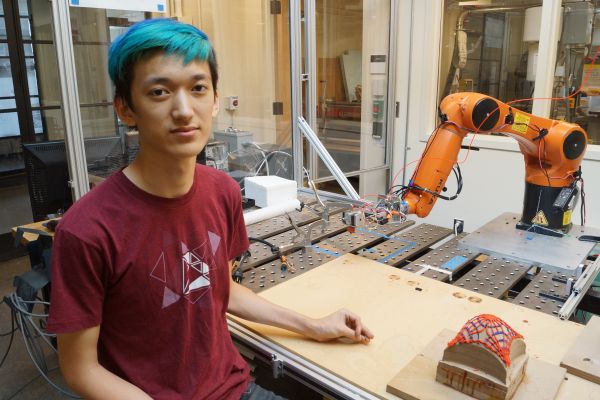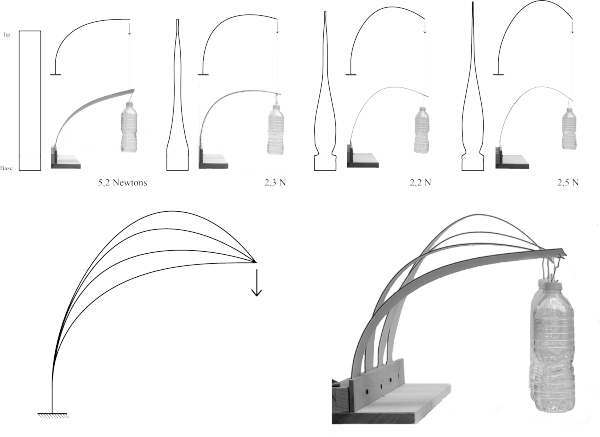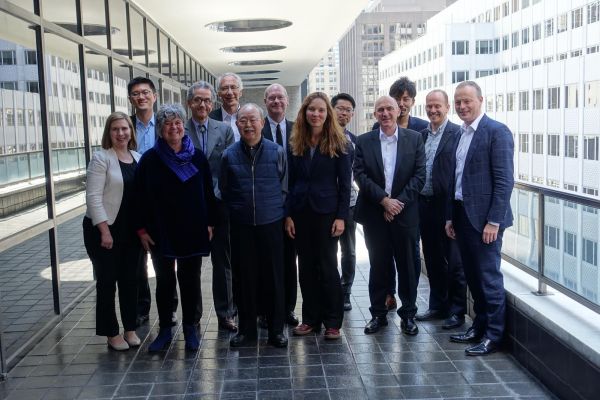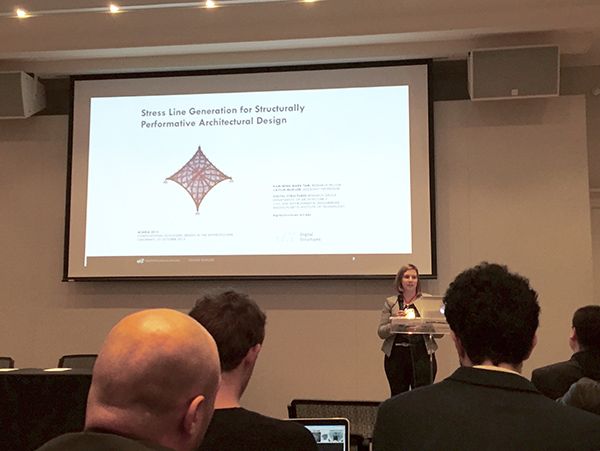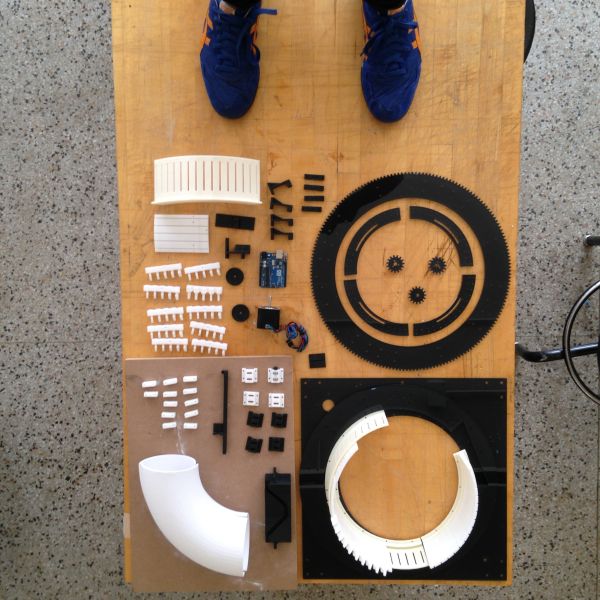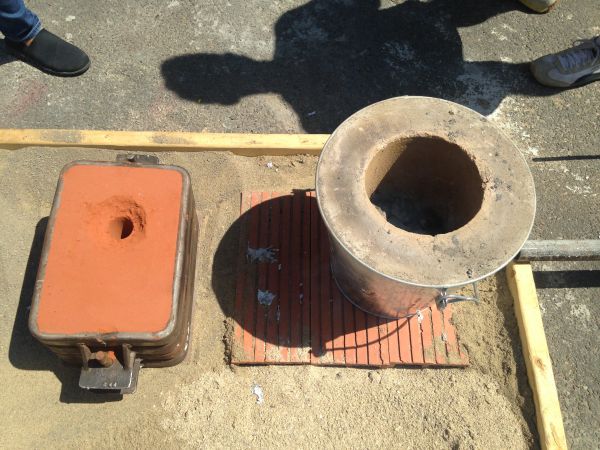people
-
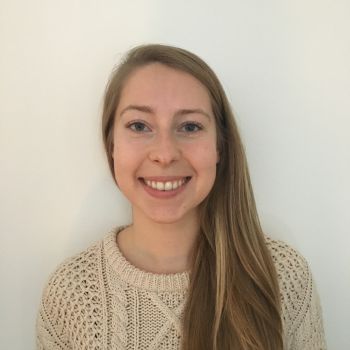 Rachel BlowesSMArchS Student
Rachel BlowesSMArchS Student -
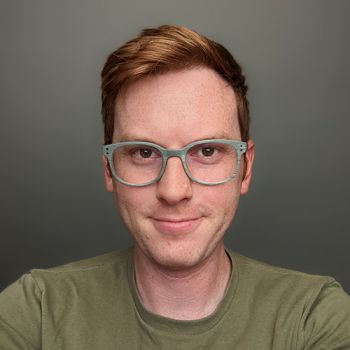 Adam BurkePhD Student
Adam BurkePhD Student -
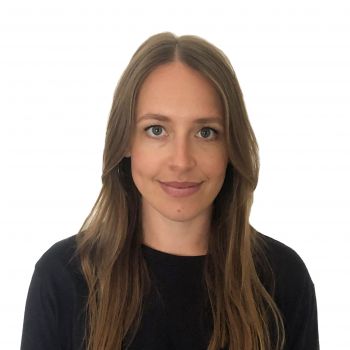 Kiley FeickertPhD Student
Kiley FeickertPhD Student -
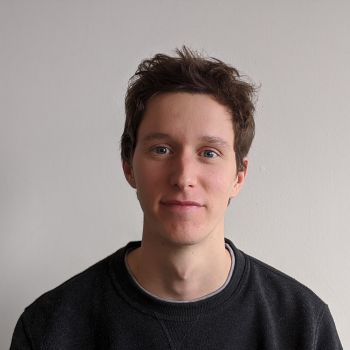 Eduardo GasconResearch Affiliate
Eduardo GasconResearch Affiliate
Rachel Blowes
SMArchS Student, Architecture
Rachel Blowes is a designer with an interdisciplinary background in architecture and structural engineering. She is interested in exploring the potential to reduce the embodied energy impact of buildings through design. She holds a Bachelor’s degree from McGill University in civil engineering and joint Master’s degrees in architecture and structural engineering from UC Berkeley. Having previously worked in architecture in Montreal, she is now pursuing graduate studies at MIT as part of the Digital Structures research group. Her current research focuses on developing approaches to characterize salvaged and irregular wood building components and incorporate them in design workflows.
Contact:

Adam Burke
PhD Student, Architecture
Adam Burke is interested in the design, simulation, and fabrication of tensile structures with non-standard topologies. He thinks that structures which rely on tension are an under-explored typology and is developing tools to help designers, architects, and engineers work more intuitively with these form-found structural systems.
His interest in fiber based lightweight architecture began during his undergraduate studies in architecture at Virginia Tech where he obtained a B.Arch. Prior to coming to MIT he also worked on large scale fiber based public sculpture as a Studio Design Fellow with artist Janet Echelman.
Contact:
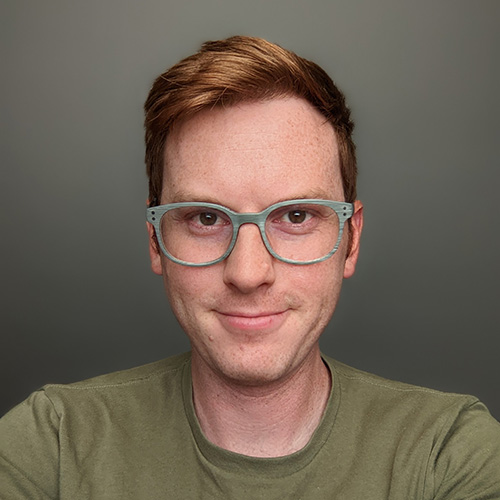
Kiley Feickert
PhD Student, Architecture
Kiley Feickert is an architect pursuing her PhD in Building Technology at MIT. She aims to reduce embodied carbon in buildings through the critical evaluation of business-as-usual construction materials and methods. Her research focuses on optimizing structural systems for material efficiency and reusing structures to reduce carbon emission and increase access to affordable construction. She also studies how digital fabrication can be leveraged to build cost-effective, yet complex forms.
Prior to joining the Building Technology Lab at MIT, Kiley practiced as an architectural designer in New York City and London. Most recently, she worked on the design and construction of Google's headquarters in Mountain View and London.
Contact:

Eduardo Gascon
Research Affiliate, Architecture
Edu joined Digital Structures as a SMArchS student in the Building Technology department at MIT, and he continued in the PhD program in Building Technology. His research work with Caitlin Mueller and Les Norford focuses on exploring the thermal potential of structural components as a strategy to reduce both embodied and operational energy associated to buildings. Prior to MIT, Edu completed his Bachelor and Master studies in Architecture in the Valles School of Architecture – ETSAV, UPC -. During that time, he participated in the construction of the sustainable house “Resso” for the 2014 Solar Decathlon competition and worked for four years in BBG, a structural consulting firm based in Barcelona. He has also collaborated with the architecture studio TAC Arquitectes.
Recent Projects:
Contact:

-
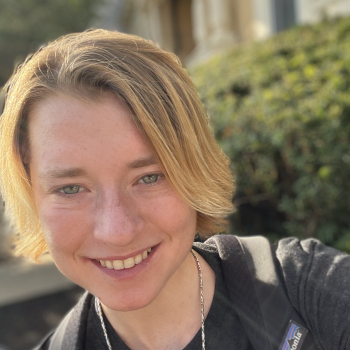 Natasha HirtSMBT Student
Natasha HirtSMBT Student -
 Chloe (Soo hwa) HongPhD Student
Chloe (Soo hwa) HongPhD Student -
 Keith LeePhD Student
Keith LeePhD Student -
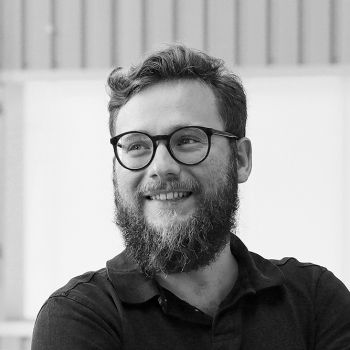 Ioannis MirtsopoulosResearch Fellow
Ioannis MirtsopoulosResearch Fellow
Natasha Hirt
SMBT Student, Architecture, Civil and Environmental Engineering
Natasha Hirt is a SMBT candidate at MIT's Digital Structures group. She is fascinated by optimal structural systems, particularly ones made out of steel and concrete (carbon fibre is great, too). Rumour has it that she is on a quest to collect as many degrees from MIT as possible. In reality, she's delighted by opportunities to learn about and apply cutting-edge computational tools to pernicious problems in structural sustainability.
Contact:

Chloe (Soo hwa) Hong
PhD Student, Architecture
Chloe Hong is interested in developing generative models that can simultaneously reason geometry, realistic conditions in the construction process such as reuse of existing materials, assembly sequences, and physical conditions such as structural behavior. She seeks to create novel designs that can be built and find better ways to build designs by advancing performance-driven methods for larger design spaces where existing optimization frames become intractable. Topics that excite her are optimization, geometric representation, physical simulation, and interpretable and customizable generative models.
Prior to coming to MIT, she received her M.S. in Computational Design at Carnegie Mellon University (CMU) and her Bachelor's at Seoul National University (SNU). She has done research in 3D model datasets during her time at Autodesk, human-centered systems for telepresence at SNU Human-Centered Computer Systems Lab, and parametric data structure fit for complex wooden joinery at SNU Architecture History Lab. She has developed computational tools to facilitate the design and fabrication for the Venice Architecture Biennale (2018), Venice Art Biennale Korea exhibition space (2019), Hyundai Outlet Mall (2019), and Hyundai Motors Future Lab (2020) with Herzog de Meuron, private galleries, and residentials.
Contact:

Keith Lee
PhD Student, Architecture
Keith is interested in quantifying and reducing structural design complexity, with a focus in construction methods and connection design. He holds a B.Eng and M.Eng in Structural Engineering from McGill University. His roots are in Seoul, Vancouver, and Montreal.
Contact:
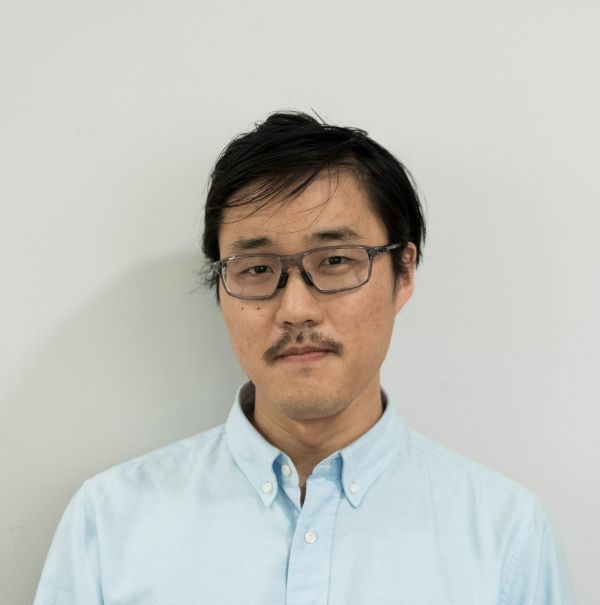
Ioannis Mirtsopoulos
Research Fellow, Architecture
Ioannis Mirtsopoulos is a Postdoctoral Researcher working on structural generative design and design space exploration (DSE) through grammar rules. Ioannis has threefold background in Architecture, Engineering and Construction (AEC): he holds a PhD in Civil Engineering from EPFL, Switzerland, where he was hosted by Structural Xploration Lab (SXL), a MAS in Architecture and Digital Fabrication from ETH Zurich, a MSc in Building Technology from TUDelft and a Diploma in Architectural Engineering from Greece. Prior to his doctoral studies, he worked at Block Research Group (BRG) at ETH Zurich. Outside of academia, Ioannis has worked as CAD/CAE software developer. Fields that he has been passionate about include programming, structural design, computational geometry, optimization, digital fabrication, robotics, material science and design digitalization. Ioannis is the developer of Libra, a Grasshopper plugin available on food4rhino.
Contact:

-
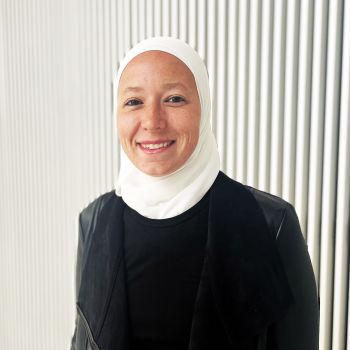 Sarah MokhtarPhD Student
Sarah MokhtarPhD Student -
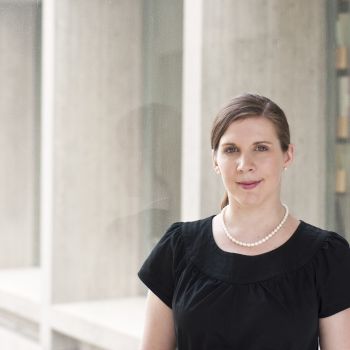 Caitlin MuellerFaculty
Caitlin MuellerFaculty -
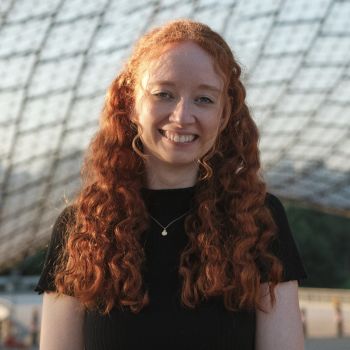 Simone PeterPhD Student
Simone PeterPhD Student -
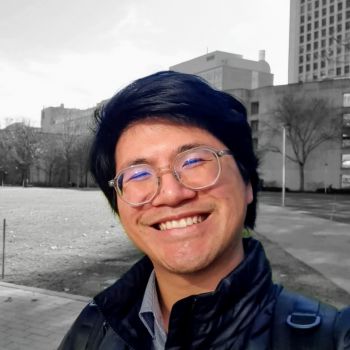 Pitipat WongsittikanPhD Student
Pitipat WongsittikanPhD Student
Sarah Mokhtar
PhD Student, Architecture
Sarah Mokhtar is an architect with research and professional interests at the intersection of design, computation and performance. She is currently pursuing a PhD in Building Technology.
Prior to MIT, Sarah worked as a Senior Environmental Performance and Computational Designer at Kohn Pedersen Fox Associates (KPF). She led applied research projects in the fields of machine learning, simulation and computation, and managed KPF's Environmental Performance (KPFep) team in the London office. She led the team in developing computational simulation tools and applying environmental performance analysis to support evidence-based design within KPF’s work.
Prior to KPF, Sarah worked as an architect for various well-established practices. She holds a MSc in Adaptive Architecture and Computation with Distinction from the Bartlett School of Architecture, UCL in 2016, and a BSc in Architectural Engineering with Highest Honors from the American University in Cairo (2014).
Contact:

Caitlin Mueller
Faculty, Architecture and Civil and Environmental Engineering
Caitlin Mueller is an academic who works at the intersection of architecture and structural engineering. She is currently an Associate Professor at the Massachusetts Institute of Technology's Department of Architecture and Department of Civil and Environmental Engineering, in the Building Technology Program, where she leads the Digital Structures research group. Professor Mueller earned a PhD in Building Technology from MIT, a SM in Computation for Design and Optimization from MIT, a MS in Structural Engineering from Stanford University, and a BS in Architecture from MIT, and has practiced at several architecture and engineering firms across the U.S., most recently as a structural designer at Simpson Gumpertz & Heger in Boston.
Recent Blog Posts:
Contact:

Simone Peter
PhD Student, Schwarzman College of Computing, Civil and Environmental Engineering
Simone is a PhD student in MIT's Computational Science and Engineering and Civil and Environmental Engineering programs, where she develops optimization methods to reduce embodied carbon in concrete building structures. Her research combines structural mechanics, computational modeling, and sustainability, with the aim of advancing performance-driven design workflows for material-efficient construction.
She holds a B.Sc. and M.Sc. (hons) from the Technical University of Munich (TUM), where she studied Civil Engineering and Computational Mechanics. Her bachelor's thesis explored interactive form-finding with the force density method, which introduced her to computational methods in structural design. During her master’s, she worked at BMW on the implementation of manufacturing constraints in the context of multidisciplinary shape optimization for automotive design.
Her background combines both research and industry experience, including work in structural engineering at Goldbeck and academic projects at TUM’s Chair of Structural Analysis focused on form finding, modeling, and optimization of lightweight structures. She also interned at Mines Paris – PSL, where she applied machine learning to accelerate nonlinear structural simulations involving meso-scale defects.
Contact:

Pitipat Wongsittikan
PhD Student, Architecture
Pitipat is interested in the area of computational design and optimization of reinforced concrete (RC) structures. He believes that digital fabrication and automation are keys to the new era of the construction industry. His research focuses on utilizing computational strategies such as design space exploration (DSE), machine learning, and constrained optimization to design data-driven-low emboded carbon RC structures. He is also exploring different fabrication methods that could facilitate automatic construction workflows of efficient structures.
Contact:

alumni
-
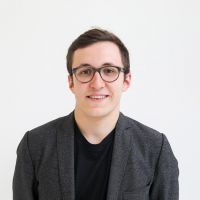 Ramon WeberPhD Degree, Architecture, 2024
Ramon WeberPhD Degree, Architecture, 2024
Next affiliation: Assistant Professor, UC BerkeleyRamon Weber is a PhD Student in Building Technology at the Massachusetts Institute of Technology with the Digital Structures Group and the Sustainable Design Lab. He graduated with a Master of Science in Media Arts and Science from the MIT Media Lab where he was part of the Mediated Matter Group. Previously, he received his master’s degree in Integrative Technologies and Architectural Design Research with distinction from the University of Stuttgart and holds a bachelor’s in architecture from ETH Zurich, where he conducted research at the Block Research Group and the Institute for Computational Design and Construction (ICD). As an architect he worked for Zaha Hadid Architects in London, where he was involved in projects across all scales and design research in the inhouse ZHA|CODE research group.
Ramon Weber
PhD Degree, Architecture, 2024
Next affiliation: Assistant Professor, UC BerkeleyRamon Weber is a PhD Student in Building Technology at the Massachusetts Institute of Technology with the Digital Structures Group and the Sustainable Design Lab. He graduated with a Master of Science in Media Arts and Science from the MIT Media Lab where he was part of the Mediated Matter Group. Previously, he received his master’s degree in Integrative Technologies and Architectural Design Research with distinction from the University of Stuttgart and holds a bachelor’s in architecture from ETH Zurich, where he conducted research at the Block Research Group and the Institute for Computational Design and Construction (ICD). As an architect he worked for Zaha Hadid Architects in London, where he was involved in projects across all scales and design research in the inhouse ZHA|CODE research group.
Recent Projects:
Contact:

-
 Karl-Johan SørensenSMArchS Degree, Architecture and Civil and Environmental Engineering, 2024
Karl-Johan SørensenSMArchS Degree, Architecture and Civil and Environmental Engineering, 2024Karl-Johan is pursuing a dual degree, combining a Master of Science in Architecture Studies (SMArchS) in Design and Computation with a Master of Science (SM) in Civil and Environmental Engineering. His research focuses on generative structural assemblies using unusual, reused parts from demolition or construction waste. Before joining MIT, Karl-Johan co-founded SAGA Space Architects - a design firm specializing in architecture and hardware designed for outer space, as well as extreme environments on Earth.
He is intrinsically fascinated with complex geometries and the techniques for building them.
Karl-Johan Sørensen
SMArchS Degree, Architecture and Civil and Environmental Engineering, 2024
Karl-Johan is pursuing a dual degree, combining a Master of Science in Architecture Studies (SMArchS) in Design and Computation with a Master of Science (SM) in Civil and Environmental Engineering. His research focuses on generative structural assemblies using unusual, reused parts from demolition or construction waste. Before joining MIT, Karl-Johan co-founded SAGA Space Architects - a design firm specializing in architecture and hardware designed for outer space, as well as extreme environments on Earth.
He is intrinsically fascinated with complex geometries and the techniques for building them.
Contact:

-
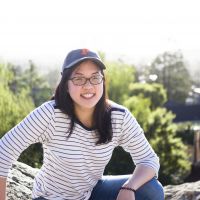 Demi FangPhD Degree, Architecture, 2023
Demi FangPhD Degree, Architecture, 2023
Next affiliation: Assistant Professor, Northeastern UniversityDemi's undergraduate exposure to form-finding and computational design at Princeton University sparked her interest in the intersection of architecture and engineering. Now a PhD student in MIT's Building Technology program, Demi is interested in how optimization techniques can be applied to structural design to enhance sustainability in the built environment.
Demi completed her SMBT with Professor Caitlin Mueller in 2020, studying the mechanical analysis and sustainability of joinery connections in modern timber construction. Demi has interned at Guy Nordenson and Associates, Silman New York, and SOM Chicago as a structural engineer and computational designer.
Demi Fang
PhD Degree, Architecture, 2023
Next affiliation: Assistant Professor, Northeastern UniversityDemi's undergraduate exposure to form-finding and computational design at Princeton University sparked her interest in the intersection of architecture and engineering. Now a PhD student in MIT's Building Technology program, Demi is interested in how optimization techniques can be applied to structural design to enhance sustainability in the built environment.
Demi completed her SMBT with Professor Caitlin Mueller in 2020, studying the mechanical analysis and sustainability of joinery connections in modern timber construction. Demi has interned at Guy Nordenson and Associates, Silman New York, and SOM Chicago as a structural engineer and computational designer.
Recent Projects:
Publications:
Recent Blog Posts:
Contact:

-
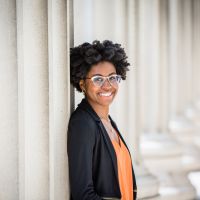 Ashley HartwellPhD Degree, Mechanical Engineering, 2023
Ashley HartwellPhD Degree, Mechanical Engineering, 2023
Next affiliation: NISTAshley is a mechanical engineer with a passion for integrating materials design with mechanical performance. Currently she designs sustainable and thermally efficient concrete structural systems inspired by filler slabs, a composite structural system popularized in India. Her research focuses on how multi-objective optimization, along with emerging digital fabrication techniques can improve overall building perfromance.
Prior to joining digital structures for her Ph.D. work, she received her B.S. at Stanford University in Mechanical Engineering where she completed research on cemetitious composite materials and completed her S.M. at MIT in Mechanical Engineering where she is also apart of the University Center for Exemplary Mentoring.
Ashley Hartwell
PhD Degree, Mechanical Engineering, 2023
Next affiliation: NISTAshley is a mechanical engineer with a passion for integrating materials design with mechanical performance. Currently she designs sustainable and thermally efficient concrete structural systems inspired by filler slabs, a composite structural system popularized in India. Her research focuses on how multi-objective optimization, along with emerging digital fabrication techniques can improve overall building perfromance.
Prior to joining digital structures for her Ph.D. work, she received her B.S. at Stanford University in Mechanical Engineering where she completed research on cemetitious composite materials and completed her S.M. at MIT in Mechanical Engineering where she is also apart of the University Center for Exemplary Mentoring.
Contact:

-
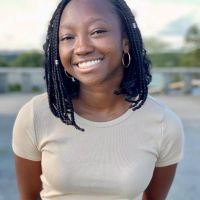 Leilah Yadia Kelly SorySMBT Degree, Architecture, 2023
Leilah Yadia Kelly SorySMBT Degree, Architecture, 2023
Next affiliation: ArupAfter completing her Bachelor's in structural engineering from McGill University in 2021, Leilah has joined the Digital Structures Group and Sustainable Design Lab for her Master's in Building Technology. Her research focuses on improving and developing computational tools and simulations to optimize embodied carbon in buildings. Her goal is to aid designers and leaders in the building industry in making sustainable decisions and positively impacting the built environment on a path towards a net-zero carbon world. Leilah enjoys playing tennis, travelling to new cities, and reading famous architects' memoirs.
Leilah Yadia Kelly Sory
SMBT Degree, Architecture, 2023
Next affiliation: ArupAfter completing her Bachelor's in structural engineering from McGill University in 2021, Leilah has joined the Digital Structures Group and Sustainable Design Lab for her Master's in Building Technology. Her research focuses on improving and developing computational tools and simulations to optimize embodied carbon in buildings. Her goal is to aid designers and leaders in the building industry in making sustainable decisions and positively impacting the built environment on a path towards a net-zero carbon world. Leilah enjoys playing tennis, travelling to new cities, and reading famous architects' memoirs.
Contact:

-
 Jaya Manideep RebbagondlaSM Degree, Computational Science and Engineering, 2023
Jaya Manideep RebbagondlaSM Degree, Computational Science and Engineering, 2023
Next affiliation: DeCoDe LabManideep is a Masters student in Computational Science and Engineering at MIT. Under the supervision of Prof. Caitlin Mueller and Prof. Leslie Norford, He is developing computational models to evaluate and optimize the performance of novel HVAC systems like membrane-based dehumidification systems. He is also interested in developing machine learning and optimization algorithms-based computational tools to enhance the combined structural and thermal performance of building structural elements. Manideep holds a bachelor’s degree in Mechanical Engineering from Indian Institute of Technology Madras where his research work was focused on Stochastic Finite Element Methods, and also has work experience of one and half years as a Mechanical Engineer at Enphase Energy, carrying out product design, thermal and structural simulation activities.
Jaya Manideep Rebbagondla
SM Degree, Computational Science and Engineering, 2023
Next affiliation: DeCoDe LabManideep is a Masters student in Computational Science and Engineering at MIT. Under the supervision of Prof. Caitlin Mueller and Prof. Leslie Norford, He is developing computational models to evaluate and optimize the performance of novel HVAC systems like membrane-based dehumidification systems. He is also interested in developing machine learning and optimization algorithms-based computational tools to enhance the combined structural and thermal performance of building structural elements. Manideep holds a bachelor’s degree in Mechanical Engineering from Indian Institute of Technology Madras where his research work was focused on Stochastic Finite Element Methods, and also has work experience of one and half years as a Mechanical Engineer at Enphase Energy, carrying out product design, thermal and structural simulation activities.
Contact:

-
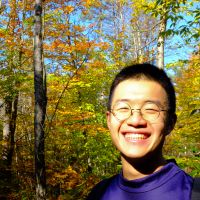 Yijiang HuangPhD Degree, Architecture, 2022
Yijiang HuangPhD Degree, Architecture, 2022
Next affiliation: Postdoctoral fellow at ETH ZurichWith a background of mathematics and computer graphics, Yijiang's research interest is on optimization and artificial intelligence's application in digital architectural construction. His current work focuses on construction sequence optimization and associated motion planning for robotic fabrication and construction.
He received Bachelor of Science in Applied Mathematics at Univ of Sci & Tech of China in 2016 and SMBT at MIT in 2018. In spare time, Yijiang enjoys playing soccer, listening to music and traveling.
Yijiang Huang
PhD Degree, Architecture, 2022
Next affiliation: Postdoctoral fellow at ETH ZurichWith a background of mathematics and computer graphics, Yijiang's research interest is on optimization and artificial intelligence's application in digital architectural construction. His current work focuses on construction sequence optimization and associated motion planning for robotic fabrication and construction.
He received Bachelor of Science in Applied Mathematics at Univ of Sci & Tech of China in 2016 and SMBT at MIT in 2018. In spare time, Yijiang enjoys playing soccer, listening to music and traveling.
Recent Projects:
Publications:
Contact:

-
 Mohamed IsmailPhD Degree, Architecture, 2022
Mohamed IsmailPhD Degree, Architecture, 2022
Next affiliation: University of VirginiaMohamed Ismail is a Ph.D. student in the Building Technology group, studying the potential application of structural and material optimization in the alleviation of housing insecurity in the Global South. Mohamed received his Bachelor in Civil and Structural Engineering at Duke University before receiving his Master of Architecture at the University of Virginia. Prior to his arrival at MIT, Mohamed was faculty lecturer at the UVa School of Architecture, teaching Parametric Structural Design and Digital Workflows. At MIT, Mohamed previously worked with the Tata Center, Caitlin Mueller, and the Digital Structures research group to design low-cost, low-carbon structural components for housing in developing economies.
Mohamed enjoys art, travel, and architectural manifestos. He also goes by Moh.
Mohamed Ismail
PhD Degree, Architecture, 2022
Next affiliation: University of VirginiaMohamed Ismail is a Ph.D. student in the Building Technology group, studying the potential application of structural and material optimization in the alleviation of housing insecurity in the Global South. Mohamed received his Bachelor in Civil and Structural Engineering at Duke University before receiving his Master of Architecture at the University of Virginia. Prior to his arrival at MIT, Mohamed was faculty lecturer at the UVa School of Architecture, teaching Parametric Structural Design and Digital Workflows. At MIT, Mohamed previously worked with the Tata Center, Caitlin Mueller, and the Digital Structures research group to design low-cost, low-carbon structural components for housing in developing economies.
Mohamed enjoys art, travel, and architectural manifestos. He also goes by Moh.
Recent Projects:
Publications:
Recent Blog Posts:
Contact:
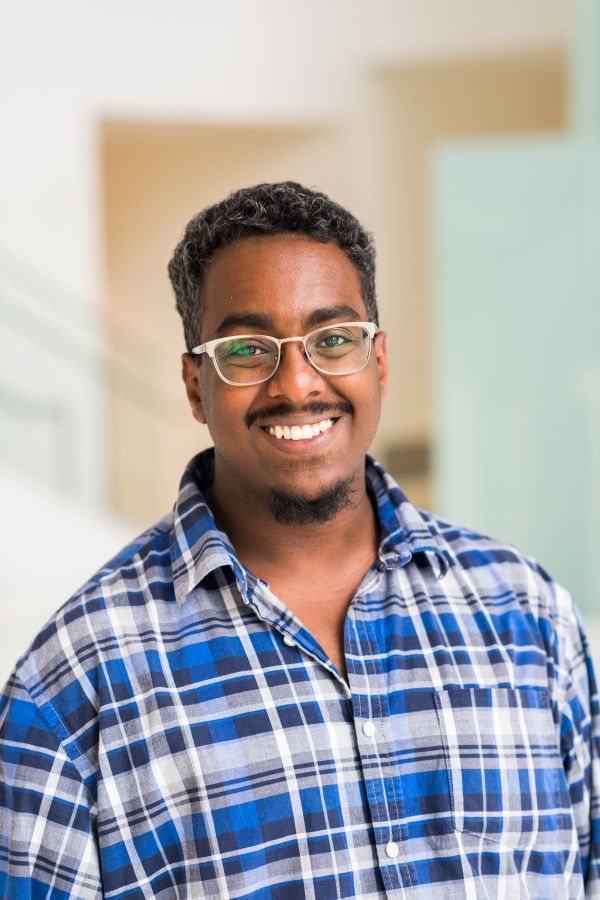
-
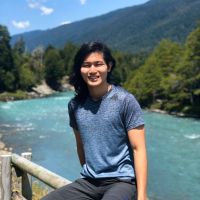 Bryan OngSM Degree, Civil and Environmental Engineering, Architecture, 2021
Bryan OngSM Degree, Civil and Environmental Engineering, Architecture, 2021Born and raised in Singapore, Bryan is a graduate student pursuing dual Master of Science programs in the Civil and Environmental Engineering as well as the Building Technology departments. He previously received his Bachelor of Science in Civil Engineering from University of California, Los Angeles, where he was also exposed to architectural theory and design. Working under Professor Caitlin Mueller, his research focuses on the application of machine learning, data analytics and optimization techniques to facilitate design exploration and creative workflows.
Bryan served as a Lieutenant in the Republic of Singapore Navy and interned at Skidmore, Owings & Merrill Los Angeles.
Bryan Ong
SM Degree, Civil and Environmental Engineering, Architecture, 2021
Born and raised in Singapore, Bryan is a graduate student pursuing dual Master of Science programs in the Civil and Environmental Engineering as well as the Building Technology departments. He previously received his Bachelor of Science in Civil Engineering from University of California, Los Angeles, where he was also exposed to architectural theory and design. Working under Professor Caitlin Mueller, his research focuses on the application of machine learning, data analytics and optimization techniques to facilitate design exploration and creative workflows.
Bryan served as a Lieutenant in the Republic of Singapore Navy and interned at Skidmore, Owings & Merrill Los Angeles.
Contact:

-
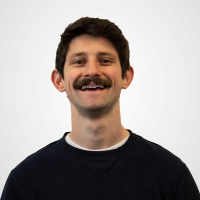 Eamon WhalenSM Degree, Computational Science and Engineering, 2021
Eamon WhalenSM Degree, Computational Science and Engineering, 2021
Next affiliation: Altair EngineeringEamon is interested in the ways that geometric machine learning are augmenting structural design. His research focuses on shape-based surrogate modeling, enabling fast performance predictions without the need to define design parameters. He is also investigating methods for embedding physical laws into surrogate models to improve their accuracy and interpretability. Eamon received is B.S.E. in mechanical engineering from the University of Michigan in 2016 and worked for Altair Engineering as an Engineering Data Scientist until 2020. He recently began a master's degree in Computation for Design and Optimizatino (CDO) at MIT.
Eamon Whalen
SM Degree, Computational Science and Engineering, 2021
Next affiliation: Altair EngineeringEamon is interested in the ways that geometric machine learning are augmenting structural design. His research focuses on shape-based surrogate modeling, enabling fast performance predictions without the need to define design parameters. He is also investigating methods for embedding physical laws into surrogate models to improve their accuracy and interpretability. Eamon received is B.S.E. in mechanical engineering from the University of Michigan in 2016 and worked for Altair Engineering as an Engineering Data Scientist until 2020. He recently began a master's degree in Computation for Design and Optimizatino (CDO) at MIT.
Contact:

-
 Renaud DanhaivePhD Degree, Architecture, 2020
Renaud DanhaivePhD Degree, Architecture, 2020Renaud Danhaive is a PhD student in Building Technology at MIT, working under the supervision of Prof. Caitlin Mueller within the Digital Structures research group. Concurrently, he is finishing his M.Sc. in Architecture and Engineering at the Free University of Brussels (ULB/VUB). Driven by his belief in creative and inclusive architectural design, he was trained as an architect and an engineer during his undergraduate studies at the Free University of Brussels where he received the highest honors upon graduation. He then came to MIT to pursue a M.Eng. in Civil and Environmental Engineering and graduated in June 2015. Passionate about the use of computation to develop design methods enabling the exploration of the structure-architecture interface, he investigated the integration of parametric modelling and interactive evolutionary optimization for his M.Eng. thesis. Advised by Prof. Caitlin Mueller, he implemented the framework in the parametric design tool stormcloud. In Brussels, he studied the mechanical properties of early-age concrete as a summer researcher at the Civil Engineering Lab of the Free University of Brussels and worked as an engineering intern at Ney and Partners.
Renaud Danhaive
PhD Degree, Architecture, 2020
Renaud Danhaive is a PhD student in Building Technology at MIT, working under the supervision of Prof. Caitlin Mueller within the Digital Structures research group. Concurrently, he is finishing his M.Sc. in Architecture and Engineering at the Free University of Brussels (ULB/VUB). Driven by his belief in creative and inclusive architectural design, he was trained as an architect and an engineer during his undergraduate studies at the Free University of Brussels where he received the highest honors upon graduation. He then came to MIT to pursue a M.Eng. in Civil and Environmental Engineering and graduated in June 2015. Passionate about the use of computation to develop design methods enabling the exploration of the structure-architecture interface, he investigated the integration of parametric modelling and interactive evolutionary optimization for his M.Eng. thesis. Advised by Prof. Caitlin Mueller, he implemented the framework in the parametric design tool stormcloud. In Brussels, he studied the mechanical properties of early-age concrete as a summer researcher at the Civil Engineering Lab of the Free University of Brussels and worked as an engineering intern at Ney and Partners.
Recent Projects:
Publications:
Contact:

-
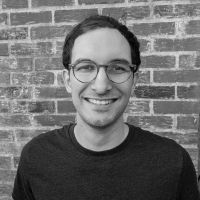 Pierre CuvilliersPhD Degree, Architecture, 2020
Pierre CuvilliersPhD Degree, Architecture, 2020Pierre is a structural engineer and designer who draws from his passion for mechanics, computation, and architecture to create innovative structural solutions. He completed his undergraduate studies and M.Sc. at Ecole Polytechnique and École des Ponts. He then practiced for one year as a facade engineer at T/E/S/S. His master thesis focused on using elastic gridshells as formwork for concrete shells, and the generation of equilibrium shapes for such structures. At MIT, he hopes to build the computational tools and theories that will tightly connect architectural design to structural principles and optimization.
Pierre Cuvilliers
PhD Degree, Architecture, 2020
Pierre is a structural engineer and designer who draws from his passion for mechanics, computation, and architecture to create innovative structural solutions. He completed his undergraduate studies and M.Sc. at Ecole Polytechnique and École des Ponts. He then practiced for one year as a facade engineer at T/E/S/S. His master thesis focused on using elastic gridshells as formwork for concrete shells, and the generation of equilibrium shapes for such structures. At MIT, he hopes to build the computational tools and theories that will tightly connect architectural design to structural principles and optimization.
Recent Projects:
Recent Blog Posts:
Contact:

-
 Paul MayencourtPhD Degree, Architecture, 2020
Paul MayencourtPhD Degree, Architecture, 2020Paul Mayencourt is a PhD student in Building Technology at MIT. He is a structural engineer who conducts research on structural optimization and digital fabrication of timber structures. Prior work includes research on digital fabrication of timber folded plate structures at IBOIS - EPFL, and several years as a practicing bridge engineer in Zurich, Switzerland.
Paul Mayencourt
PhD Degree, Architecture, 2020
Paul Mayencourt is a PhD student in Building Technology at MIT. He is a structural engineer who conducts research on structural optimization and digital fabrication of timber structures. Prior work includes research on digital fabrication of timber folded plate structures at IBOIS - EPFL, and several years as a practicing bridge engineer in Zurich, Switzerland.
Recent Projects:
Publications:
Recent Blog Posts:
Contact:
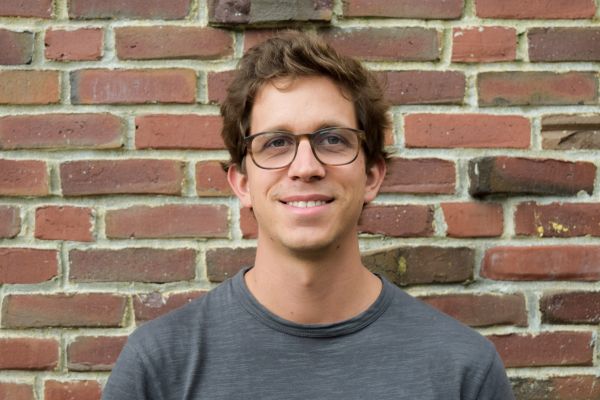
-
 Eric WongBS Degree, Civil and Environmental Engineering, 2020
Eric WongBS Degree, Civil and Environmental Engineering, 2020Eric Wong is an undergraduate student in Civil Engineering who explores computational design within sturctural engineering. He most recently worked on utilizing various machine learning techniques to capture individuals' architectural aesthetic. He has worked as a UROP student within the Digital Structures group to explore diversity metrics and tackle environmental design through beam profile optimization.
Eric Wong
BS Degree, Civil and Environmental Engineering, 2020
Eric Wong is an undergraduate student in Civil Engineering who explores computational design within sturctural engineering. He most recently worked on utilizing various machine learning techniques to capture individuals' architectural aesthetic. He has worked as a UROP student within the Digital Structures group to explore diversity metrics and tackle environmental design through beam profile optimization.
Contact:

-
 Diego RiveraMEng Degree, Civil and Environmental Engineering, 2020
Diego RiveraMEng Degree, Civil and Environmental Engineering, 2020Originally from Morro Bay, California, Diego graduated from Cal Poly, San Luis Obispo, with a B.S. in civil engineering. Curious about optimization and computational design, he then came to MIT, where he is pursuing a Master of Engineering in Civil and Environmental Engineering and working within the Digital Structures research group. With plans to eventually work as a practicing structural engineer, Diego is particularly interested in the integration of art, architecture, and engineering, and how collaborative design can invigorate our built environment in a beautiful and stimulating way. His current research within the Digital Structures group regards the optimization of patterned surface structures, such as plates and shells, as it relates to conceptual design exploration and structural engineering application. In addition to his passion for structures, Diego also enjoys art, hiking, and playing basketball.
Diego Rivera
MEng Degree, Civil and Environmental Engineering, 2020
Originally from Morro Bay, California, Diego graduated from Cal Poly, San Luis Obispo, with a B.S. in civil engineering. Curious about optimization and computational design, he then came to MIT, where he is pursuing a Master of Engineering in Civil and Environmental Engineering and working within the Digital Structures research group. With plans to eventually work as a practicing structural engineer, Diego is particularly interested in the integration of art, architecture, and engineering, and how collaborative design can invigorate our built environment in a beautiful and stimulating way. His current research within the Digital Structures group regards the optimization of patterned surface structures, such as plates and shells, as it relates to conceptual design exploration and structural engineering application. In addition to his passion for structures, Diego also enjoys art, hiking, and playing basketball.
Contact:

-
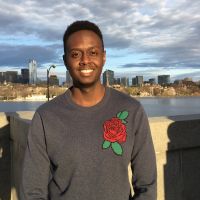 Herbert NuwagabaMEng Degree, Civil and Environmental Engineering, 2020
Herbert NuwagabaMEng Degree, Civil and Environmental Engineering, 2020Herbert Nuwagaba, originally from Uganda, is a graduate student pursuing a Master of Engineering in Structural Mechanics and Design from the Department of Civil and Environmental Engineering at MIT. In the Digital Structures Group, his research is focused on opportunities for affordable construction in Uganda using locally available materials. Before this, Herbert received his B.S. in Civil Engineering from the University of Illinois at Chicago. Herbert draws his inspiration for his research at MIT from the time he spent living in Uganda. Here, he realized how poor infrastructure and housing facilities affected the quality of life in the country. Herbert wants his research at MIT to inspire change and eventually make his dream of having better and affordable infrastructure a reality in Uganda. Aside from his research, Herbert plans to work as a structural engineer in the New York City area. In addition to his passion for improving infrastructure in Uganda, Herbert enjoys playing soccer, going for walks in the park, and baking.
Herbert Nuwagaba
MEng Degree, Civil and Environmental Engineering, 2020
Herbert Nuwagaba, originally from Uganda, is a graduate student pursuing a Master of Engineering in Structural Mechanics and Design from the Department of Civil and Environmental Engineering at MIT. In the Digital Structures Group, his research is focused on opportunities for affordable construction in Uganda using locally available materials. Before this, Herbert received his B.S. in Civil Engineering from the University of Illinois at Chicago. Herbert draws his inspiration for his research at MIT from the time he spent living in Uganda. Here, he realized how poor infrastructure and housing facilities affected the quality of life in the country. Herbert wants his research at MIT to inspire change and eventually make his dream of having better and affordable infrastructure a reality in Uganda. Aside from his research, Herbert plans to work as a structural engineer in the New York City area. In addition to his passion for improving infrastructure in Uganda, Herbert enjoys playing soccer, going for walks in the park, and baking.
Contact:

-
 Courtney StephenSM Degree, Civil and Environmental Engineering, 2019
Courtney StephenSM Degree, Civil and Environmental Engineering, 2019
Next affiliation: Skidmore, Owings & MerrillCourtney Stephen is a Master of Science student in the Civil and Environmental Engineering Department at MIT. She is interested in structural forms and optimization and their influence on architectural design. Courtney is currently working under Prof. Mueller on FEMA Post-Disaster Housing research in collaboration with the MIT Urban Risk Lab. She previously earned her BS in Civil Engineering - Structures from Texas A&M University and worked as a civil engineer in Houston for two years before joining the Digital Structures Lab. Courtney enjoys traveling to visit notable architectural monuments and structures and admires the influences of timeless Asian architectural forms on modern architecture.
Courtney Stephen
SM Degree, Civil and Environmental Engineering, 2019
Next affiliation: Skidmore, Owings & MerrillCourtney Stephen is a Master of Science student in the Civil and Environmental Engineering Department at MIT. She is interested in structural forms and optimization and their influence on architectural design. Courtney is currently working under Prof. Mueller on FEMA Post-Disaster Housing research in collaboration with the MIT Urban Risk Lab. She previously earned her BS in Civil Engineering - Structures from Texas A&M University and worked as a civil engineer in Houston for two years before joining the Digital Structures Lab. Courtney enjoys traveling to visit notable architectural monuments and structures and admires the influences of timeless Asian architectural forms on modern architecture.
Recent Projects:
Contact:

-
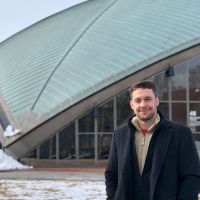 Felix AmtsbergResearch Fellow, Architecture, 2019
Felix AmtsbergResearch Fellow, Architecture, 2019
Next affiliation: Institute for Computational Design and Construction (ICD), University of StuttgartFelix Amtsberg is SUTD-MIT Postdoctoral Fellow who's research interest focus on digital fabrication of load carrying structures and sensory informed production. After completing his apprenticeship as a joiner (carpenter and furniture maker) in Germany, he studied architecture at University of Kassel and received his Masters degree. From 2011 to 2016 he has worked as a Scientific Assistant at the Institute for Structural Design, (Graz University of Technology) in Austria, where he was coordinating the ABB Robotic Research and Teaching Laboratory and earned his PhD in 2016. After his first year as a postdoc at Singapore University of Technology and Design, he is now part Digital Structures group to intensify his research on the combination of unprocessed natural construction materials and digital fabrication methods.
When not working, Felix enjoys various sportive activities, is a passionate mountaineer and plays guitar.
Felix Amtsberg
Research Fellow, Architecture, 2019
Next affiliation: Institute for Computational Design and Construction (ICD), University of StuttgartFelix Amtsberg is SUTD-MIT Postdoctoral Fellow who's research interest focus on digital fabrication of load carrying structures and sensory informed production. After completing his apprenticeship as a joiner (carpenter and furniture maker) in Germany, he studied architecture at University of Kassel and received his Masters degree. From 2011 to 2016 he has worked as a Scientific Assistant at the Institute for Structural Design, (Graz University of Technology) in Austria, where he was coordinating the ABB Robotic Research and Teaching Laboratory and earned his PhD in 2016. After his first year as a postdoc at Singapore University of Technology and Design, he is now part Digital Structures group to intensify his research on the combination of unprocessed natural construction materials and digital fabrication methods.
When not working, Felix enjoys various sportive activities, is a passionate mountaineer and plays guitar.
Contact:

-
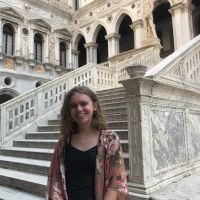 Violetta JusiegaBS Degree, Computer Science, 2019
Violetta JusiegaBS Degree, Computer Science, 2019Violetta Jusiega is an undergraduate student working as a UROP researcher with the Digital Structures research group. Her primary work has been contributing to the Design Space Exploration tool suite.
-
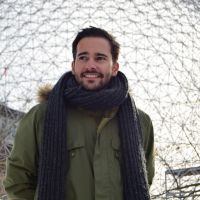 Kevin Moreno GataVisiting Researcher, Architecture, 2019
Kevin Moreno GataVisiting Researcher, Architecture, 2019
Next affiliation: Ph.D. at RWTH Aachen UniversityKevin Moreno is a visiting student, whose research interest focuses on computational design and digital fabrication.
He is Architect by the University of Alcala (Spain) where he was awarded to the most outstanding graduate in Architecture in 2017, and also works as a research collaborator in the Department of Architecture. In addition, Kevin has completed his education at the RWTH Aachen University (Germany), where he was working as a research assistant in the Chair of Structures and Structural Design. He was granted to work as an Intern Architect for the General Subdivision or Architecture, in the Ministry of Development, Spanish Government, collaborating on the Spanish Technical Building Code and heritage conservation, and with the Institute of Construction Sciences Eduardo Torroja.
His research is focused on the design and manufacturing of assemblies, working at the same time as a fabricator for sculpture constructions. He is now part Digital Structures group to intensify his research on topological interlocking and robotic fabrication.
Kevin Moreno Gata
Visiting Researcher, Architecture, 2019
Next affiliation: Ph.D. at RWTH Aachen UniversityKevin Moreno is a visiting student, whose research interest focuses on computational design and digital fabrication.
He is Architect by the University of Alcala (Spain) where he was awarded to the most outstanding graduate in Architecture in 2017, and also works as a research collaborator in the Department of Architecture. In addition, Kevin has completed his education at the RWTH Aachen University (Germany), where he was working as a research assistant in the Chair of Structures and Structural Design. He was granted to work as an Intern Architect for the General Subdivision or Architecture, in the Ministry of Development, Spanish Government, collaborating on the Spanish Technical Building Code and heritage conservation, and with the Institute of Construction Sciences Eduardo Torroja.
His research is focused on the design and manufacturing of assemblies, working at the same time as a fabricator for sculpture constructions. He is now part Digital Structures group to intensify his research on topological interlocking and robotic fabrication.
Contact:

-
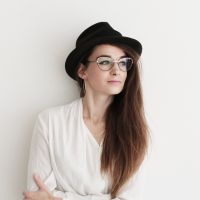 Judyta CichockaMEng Degree, Civil and Environmental Engineering, 2019
Judyta CichockaMEng Degree, Civil and Environmental Engineering, 2019Judyta is a passionate researcher and entrepreneur in the field of Architectural Design Optimization (ADO) and structural art. Her main focus lies in Multi-Objective Optimization based on Computational Intelligence methods applied in structural and architectural design. She aspires to be a researcher with a strong focus on real-world applications and an innovation-oriented computational engineer.
Prior joining MIT Judyta was a running a Berlin-based start-up: Parametric Support. She is a founder of Code of Space organization and the main partner of Absolute Joint System in Poland. She tutored on parametric design at Victoria University of Wellington, Universitat der Kunste in Berlin & at the most renown conferences on computational design such as: Advances of Architectural Geometry 2014 and 2016, CAADRIA 2017 in China or IASS 2017 in Hamburg. Judyta received Polish Minister of Education’s award for outstanding young scientists in 2016 and she is a Fulbright Graduate scholar 2017.
Judyta Cichocka
MEng Degree, Civil and Environmental Engineering, 2019
Judyta is a passionate researcher and entrepreneur in the field of Architectural Design Optimization (ADO) and structural art. Her main focus lies in Multi-Objective Optimization based on Computational Intelligence methods applied in structural and architectural design. She aspires to be a researcher with a strong focus on real-world applications and an innovation-oriented computational engineer.
Prior joining MIT Judyta was a running a Berlin-based start-up: Parametric Support. She is a founder of Code of Space organization and the main partner of Absolute Joint System in Poland. She tutored on parametric design at Victoria University of Wellington, Universitat der Kunste in Berlin & at the most renown conferences on computational design such as: Advances of Architectural Geometry 2014 and 2016, CAADRIA 2017 in China or IASS 2017 in Hamburg. Judyta received Polish Minister of Education’s award for outstanding young scientists in 2016 and she is a Fulbright Graduate scholar 2017.
Recent Projects:
Contact:

-
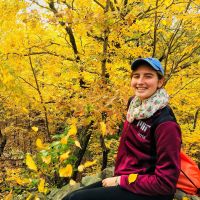 Abigail AndersonMEng Degree, Civil and Environmental Engineering, 2019
Abigail AndersonMEng Degree, Civil and Environmental Engineering, 2019
Next affiliation: Simpson Gumpertz & HegerAbigail is a Master's student in Civil Engineering who explores the intersection between structural design and construction in the developing world. She is currently working to optimize reinforced concrete beam and slab geometry within the constraints of construction in India. She completed her Bachelor's in Architecture Studies at MIT in June 2018. In the past, Abigail has researched roofing materials for use in a housing community in Rwanda; Guastavino tile locations and history in Italy; and incremental housing architecture in Colombia. She also works at MIT's D-Lab, through which she's been involved in a number of international development projects in different sectors.
She loves to dance, play piano, travel, read historical and philosophical books, and adventure with friends.
Abigail Anderson
MEng Degree, Civil and Environmental Engineering, 2019
Next affiliation: Simpson Gumpertz & HegerAbigail is a Master's student in Civil Engineering who explores the intersection between structural design and construction in the developing world. She is currently working to optimize reinforced concrete beam and slab geometry within the constraints of construction in India. She completed her Bachelor's in Architecture Studies at MIT in June 2018. In the past, Abigail has researched roofing materials for use in a housing community in Rwanda; Guastavino tile locations and history in Italy; and incremental housing architecture in Colombia. She also works at MIT's D-Lab, through which she's been involved in a number of international development projects in different sectors.
She loves to dance, play piano, travel, read historical and philosophical books, and adventure with friends.
Contact:

-
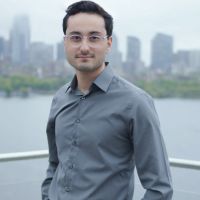 Daniel LandezBSA Degree, Architecture, 2019
Daniel LandezBSA Degree, Architecture, 2019Daniel Landez is an undergraduate student in the school of Architecture interested in sustainable building technologies, public interest design, and applications of theater in architecture. Daniel’s work with Digital Structure’s has focused on experimental analysis of timber specimens.
Daniel Landez
BSA Degree, Architecture, 2019
Daniel Landez is an undergraduate student in the school of Architecture interested in sustainable building technologies, public interest design, and applications of theater in architecture. Daniel’s work with Digital Structure’s has focused on experimental analysis of timber specimens.
Contact:

-
 Brenda SternMEng Degree, Civil and Environmental Engineering, 2018
Brenda SternMEng Degree, Civil and Environmental Engineering, 2018
Next affiliation: Thornton TomasettiBrenda Stern is a Master of Engineering student in the Civil and Environmental Engineering Department at MIT. She is interested sustainable structural design, particularly through the use of optimization tools. Her thesis work investigates how multi-material structural optimization can create truss structures with less embodied carbon than traditionally designed trusses. Brenda previously received her S.B. in Civil and Environmental Engineering from MIT in 2017. When not working, Brenda enjoys ice skating, cooking, and gardening.
Brenda Stern
MEng Degree, Civil and Environmental Engineering, 2018
Next affiliation: Thornton TomasettiBrenda Stern is a Master of Engineering student in the Civil and Environmental Engineering Department at MIT. She is interested sustainable structural design, particularly through the use of optimization tools. Her thesis work investigates how multi-material structural optimization can create truss structures with less embodied carbon than traditionally designed trusses. Brenda previously received her S.B. in Civil and Environmental Engineering from MIT in 2017. When not working, Brenda enjoys ice skating, cooking, and gardening.
Recent Projects:
Contact:
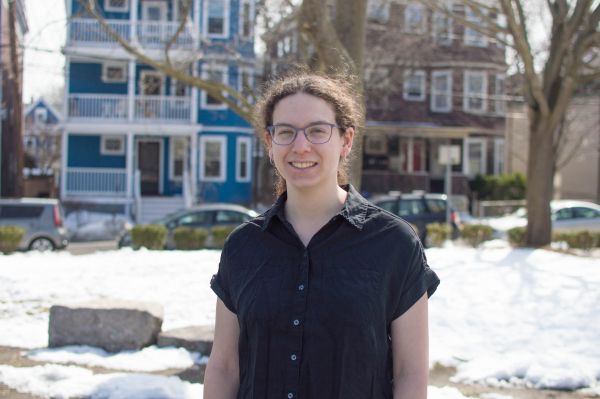
-
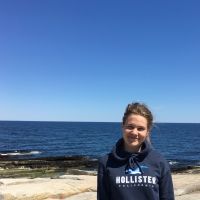 Hanne CloesenVisiting Researcher, Architecture/Civil and Environmental Engineering, 2018
Hanne CloesenVisiting Researcher, Architecture/Civil and Environmental Engineering, 2018
Next affiliation: Ecole Polytechnique Fédérale de LausanneHanne is a Master of Science student in the Civil Engineering Department at the Ecole Polytechnique Fédérale de Lausanne (EPFL, CH), where she previously earned her BSc in Civil Engineering. She is currently enrolled as a visiting student in the Building Technology Lab at MIT to work on her master's project. Stimulated by a background in structural engineering and a growing interest in computer programming, her actual work focuses on the optimization of a grammar based algorithm for truss topologies. Her project is co-directed by Caitlin Mueller and Corentin Fivet (Structural Xploration Lab - EPFL). Prior experience includes internships at Ney & Partners (Brussels, BE) and Schnetzer Puskas Ingenieure (Basel, CH).
Hanne Cloesen
Visiting Researcher, Architecture/Civil and Environmental Engineering, 2018
Next affiliation: Ecole Polytechnique Fédérale de LausanneHanne is a Master of Science student in the Civil Engineering Department at the Ecole Polytechnique Fédérale de Lausanne (EPFL, CH), where she previously earned her BSc in Civil Engineering. She is currently enrolled as a visiting student in the Building Technology Lab at MIT to work on her master's project. Stimulated by a background in structural engineering and a growing interest in computer programming, her actual work focuses on the optimization of a grammar based algorithm for truss topologies. Her project is co-directed by Caitlin Mueller and Corentin Fivet (Structural Xploration Lab - EPFL). Prior experience includes internships at Ney & Partners (Brussels, BE) and Schnetzer Puskas Ingenieure (Basel, CH).
Contact:

-
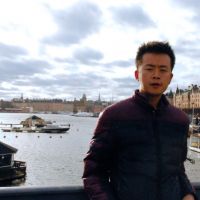 Kam-Ming Mark TamResearch Fellow, MIT-SUTD Collaboration, 2017
Kam-Ming Mark TamResearch Fellow, MIT-SUTD Collaboration, 2017
Next affiliation: Thornton Tomasetti CORE StudioKam-Ming Mark Tam is a researcher broadly engaged with computational design in architecture, who is currently an Instructor at the Singapore University of Technology (SUTD), and a Research Associate at the Massachusetts Institute of Technology (MIT) through the MIT-SUTD Graduate Fellows Program. With a research repertoire that encompasses architectural, structural, and urban design and research, Tam is currently investigating computational methods for geometric and topological design space exploration, and experimenting with novel robotic-enabled and stress-based additive manufacturing techniques for creating performative 3D-printed artifacts. Recently graduated, Tam earned a MEng in Civil Engineering from MIT, and a MArch and a BAS (with Economics Minor) from the University of Waterloo, and has practiced in several architectural firms, including Coop Himmelb(l)au in Vienna, and Cannon Design in Vancouver.
Kam-Ming Mark Tam
Research Fellow, MIT-SUTD Collaboration, 2017
Next affiliation: Thornton Tomasetti CORE StudioKam-Ming Mark Tam is a researcher broadly engaged with computational design in architecture, who is currently an Instructor at the Singapore University of Technology (SUTD), and a Research Associate at the Massachusetts Institute of Technology (MIT) through the MIT-SUTD Graduate Fellows Program. With a research repertoire that encompasses architectural, structural, and urban design and research, Tam is currently investigating computational methods for geometric and topological design space exploration, and experimenting with novel robotic-enabled and stress-based additive manufacturing techniques for creating performative 3D-printed artifacts. Recently graduated, Tam earned a MEng in Civil Engineering from MIT, and a MArch and a BAS (with Economics Minor) from the University of Waterloo, and has practiced in several architectural firms, including Coop Himmelb(l)au in Vienna, and Cannon Design in Vancouver.
Recent Projects:
Publications:
Contact:

-
 Noor KhouriSMBT Degree, Architecture, 2017
Noor KhouriSMBT Degree, Architecture, 2017Noor Khouri is a Masters student in the Building Technology program at MIT, where she also completed her undergraduate degree in Civil Engineering. Of the many challenges that are faced in the architecture, engineering and construction industry, Noor is particularly interested in the issue of enhancing the conceptual design experience through computational tools that encourage a collaborative and synergistic approach to architectural and structural design. She hopes to study this problem through the lens of geometric patterns which provide elegant design solutions where aesthetic architectural features and structural systems are more tightly intertwined.
Noor Khouri
SMBT Degree, Architecture, 2017
Noor Khouri is a Masters student in the Building Technology program at MIT, where she also completed her undergraduate degree in Civil Engineering. Of the many challenges that are faced in the architecture, engineering and construction industry, Noor is particularly interested in the issue of enhancing the conceptual design experience through computational tools that encourage a collaborative and synergistic approach to architectural and structural design. She hopes to study this problem through the lens of geometric patterns which provide elegant design solutions where aesthetic architectural features and structural systems are more tightly intertwined.
Recent Projects:
Contact:

-
 Zhao MaMArch Degree, Architecture and Civil and Environmental Engineering, 2017
Zhao MaMArch Degree, Architecture and Civil and Environmental Engineering, 2017
Next affiliation: PhD at ETH ZurichZhao MA is a current graduate student at MIT in both the Master of Architecture program in the Department of Architecture and the Master of Engineering in the Department of Civil and Environmental Engineering.
Trained academically and professionally as both an architect and a structural engineer, Zhao seeks to discover new methods of design thinking and making across disciplines and scales. Believing computation is the language to bridge multiple disciplines, Zhao hopes to develop deeper integration between traditionally disparate disciplines, as well as combining emerging disciplines to broaden the possibility of design.
Previously, Zhao has collaborated with designers, architects, structural enginners and scientists on a wide range of projects, both commercial-based and research-based, including super-highrise tower, historic renovation of industrial factory, rule-based generative urban planning, soft-formwork casting system, drone-based additive manufacturing system.
Zhao has a bachelor degree of engineering from Beihang University (Beijing University of Aeronautics and Astronautics) in China. Trained as a physicist at the beginning, Zhao has a solid background in mathematics and physics which later support his multi-disciplinary exploration. The undergraduate education also enrich Zhao’s mind for chasing the essence of the things under the surface.
Separation causes solidity; blurrines brings uncertainty. What Zhao tries to achieve is a deep integration across disciplines that finally erase the clear boundaries and new discovery will emerge from the blurry sea of knowledge afterwards. A "tree" of sustainable building environment that absorb nutrients from different soil and finally touch the untouchable sky.
His main research interest includes the rigorous exploration of design, fabrication and construction techniques across different scales, and discovering new opportunities across disciplines by utilising computation methods.Zhao Ma
MArch Degree, Architecture and Civil and Environmental Engineering, 2017
Next affiliation: PhD at ETH ZurichZhao MA is a current graduate student at MIT in both the Master of Architecture program in the Department of Architecture and the Master of Engineering in the Department of Civil and Environmental Engineering.
Trained academically and professionally as both an architect and a structural engineer, Zhao seeks to discover new methods of design thinking and making across disciplines and scales. Believing computation is the language to bridge multiple disciplines, Zhao hopes to develop deeper integration between traditionally disparate disciplines, as well as combining emerging disciplines to broaden the possibility of design.
Previously, Zhao has collaborated with designers, architects, structural enginners and scientists on a wide range of projects, both commercial-based and research-based, including super-highrise tower, historic renovation of industrial factory, rule-based generative urban planning, soft-formwork casting system, drone-based additive manufacturing system.
Zhao has a bachelor degree of engineering from Beihang University (Beijing University of Aeronautics and Astronautics) in China. Trained as a physicist at the beginning, Zhao has a solid background in mathematics and physics which later support his multi-disciplinary exploration. The undergraduate education also enrich Zhao’s mind for chasing the essence of the things under the surface.
Separation causes solidity; blurrines brings uncertainty. What Zhao tries to achieve is a deep integration across disciplines that finally erase the clear boundaries and new discovery will emerge from the blurry sea of knowledge afterwards. A "tree" of sustainable building environment that absorb nutrients from different soil and finally touch the untouchable sky.
His main research interest includes the rigorous exploration of design, fabrication and construction techniques across different scales, and discovering new opportunities across disciplines by utilising computation methods.Contact:

-
 Yu ZhangSM Degree, Civil and Environmental Engineering, 2017
Yu ZhangSM Degree, Civil and Environmental Engineering, 2017
Next affiliation: Disney ResearchYu Zhang is a current graduate student in Civil and Environmental Engineering at MIT. She is interested in computational design and machine learning. She is now working on the topology optimization for lateral systems in high-rise buildings under the supervision of Prof. Caitlin Mueller. She thinks this is a brand-new as well as promising field that combines both architectural design and structural performance.
Yu Zhang
SM Degree, Civil and Environmental Engineering, 2017
Next affiliation: Disney ResearchYu Zhang is a current graduate student in Civil and Environmental Engineering at MIT. She is interested in computational design and machine learning. She is now working on the topology optimization for lateral systems in high-rise buildings under the supervision of Prof. Caitlin Mueller. She thinks this is a brand-new as well as promising field that combines both architectural design and structural performance.
Contact:

-
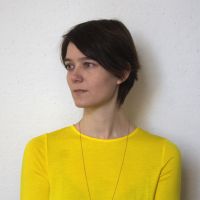 Inés ArizaResearch Affiliate, Architecture, 2017
Inés ArizaResearch Affiliate, Architecture, 2017
Next affiliation: PhD at ETH-ZurichInés Ariza is an architect from Buenos Aires, currently working as a researcher in the Digital Structures group. Through her current research work, Inés is developing digital workflows for physics and assembly-based construction details, merging her previous research on robotic assembly and ruled-based discretization algorithms for precast concrete structures. Inés holds a diploma in Architecture from the University of Buenos Aires, and a MS in Design and Computation from MIT. Prior to coming to MIT, she practiced as an architect in Argentina, with particular involvement in the detail design and construction phases. Alongside her professional practice, Inés taught Morphology and Geometric Representation at University of Buenos Aires, served as a teaching assistant at MIT for design and fabrication courses (Un-flat Inevitabilities Integrated Form and Structure in the age of Simulation and Composites; How To Make (Almost) Anything) and as a shop monitor at the MIT Architecture Shops. Inés has also served as a 2014-2016 Fulbright Scholar, and as a 2016 Quarra Matter Fellow.
Inés Ariza
Research Affiliate, Architecture, 2017
Next affiliation: PhD at ETH-ZurichInés Ariza is an architect from Buenos Aires, currently working as a researcher in the Digital Structures group. Through her current research work, Inés is developing digital workflows for physics and assembly-based construction details, merging her previous research on robotic assembly and ruled-based discretization algorithms for precast concrete structures. Inés holds a diploma in Architecture from the University of Buenos Aires, and a MS in Design and Computation from MIT. Prior to coming to MIT, she practiced as an architect in Argentina, with particular involvement in the detail design and construction phases. Alongside her professional practice, Inés taught Morphology and Geometric Representation at University of Buenos Aires, served as a teaching assistant at MIT for design and fabrication courses (Un-flat Inevitabilities Integrated Form and Structure in the age of Simulation and Composites; How To Make (Almost) Anything) and as a shop monitor at the MIT Architecture Shops. Inés has also served as a 2014-2016 Fulbright Scholar, and as a 2016 Quarra Matter Fellow.
Contact:

-
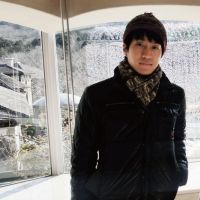 Kazuki HayashiVisiting Researcher, Graduate School of Engineering, Kyoto University, 2017
Kazuki HayashiVisiting Researcher, Graduate School of Engineering, Kyoto University, 2017
Next affiliation: Kyoto UniversityKazuki Hayashi is pursuing his master degree in Kyoto University. He joined the Digital Structures research group in 2017 as a three-month visiting student at MIT. His goal is enabling architects and structural engineers to realize their new generation design by taking an interfacial roll between them. Kazuki got involved in developing a new method of simultaneous optimization of geometry and topology for truss structures, which resulted in a grasshopper component.
Kazuki Hayashi
Visiting Researcher, Graduate School of Engineering, Kyoto University, 2017
Next affiliation: Kyoto UniversityKazuki Hayashi is pursuing his master degree in Kyoto University. He joined the Digital Structures research group in 2017 as a three-month visiting student at MIT. His goal is enabling architects and structural engineers to realize their new generation design by taking an interfacial roll between them. Kazuki got involved in developing a new method of simultaneous optimization of geometry and topology for truss structures, which resulted in a grasshopper component.
Recent Projects:
Contact:

-
 Anthony McHughMEng Degree, Civil and Environmental Engineering, 2017
Anthony McHughMEng Degree, Civil and Environmental Engineering, 2017Anthony is an aspiring structural engineer who is passionate about improving software workflows in the design process.
-
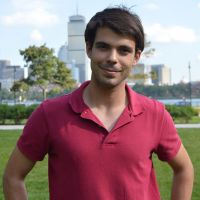 Javier Cañada Pérez-SalaVisiting Researcher, Architecture, 2017
Javier Cañada Pérez-SalaVisiting Researcher, Architecture, 2017
Next affiliation: Technical University of MadridJavier is pursuing a master degree in civil engineering between the Technical University of Madrid and the École des Ponts et Chaussées in Paris and focusing in structural engineering. He was a visiting student at MIT, joining the Digital Structures research group for the summer 2017.
He is interested in funicular behavior of structures and particularly in extending to the third dimension the use of external post-tensioning systems to convert a non-funicular structure into a funicular one. To achieve this, he is involved in exploring the possibilities of the recently developed methods in 3D graphic statics.
Javier Cañada Pérez-Sala
Visiting Researcher, Architecture, 2017
Next affiliation: Technical University of MadridJavier is pursuing a master degree in civil engineering between the Technical University of Madrid and the École des Ponts et Chaussées in Paris and focusing in structural engineering. He was a visiting student at MIT, joining the Digital Structures research group for the summer 2017.
He is interested in funicular behavior of structures and particularly in extending to the third dimension the use of external post-tensioning systems to convert a non-funicular structure into a funicular one. To achieve this, he is involved in exploring the possibilities of the recently developed methods in 3D graphic statics.
Recent Projects:
Contact:

-
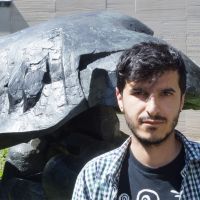 Alexandros CharidisSMArchS Degree, Architecture, 2016
Alexandros CharidisSMArchS Degree, Architecture, 2016
Next affiliation: Ph.D. at MIT Architecture, Computation GroupAlexandros is a graduate student in the MIT Department of Architecture currently pursuing a SMArchS degree in Design & Computation. His work in the Digital Structures group focuses on shape blending, a vast area of shape transformations in computer graphics, which he borrows to formulate design spaces that mediate designs in transitional states: functional, performative, material. Alexandros is interested in the theory and epistemology that shaped the early foundations of the design computing field, especially in issues of computational representation of design knowledge. In addition, he has produced electronic music semi-professionally since his high school years. He holds a professional Diploma in Architectural Engineering from the Aristotle University of Thessaloniki, School of Architecture in Greece.
Alexandros Charidis
SMArchS Degree, Architecture, 2016
Next affiliation: Ph.D. at MIT Architecture, Computation GroupAlexandros is a graduate student in the MIT Department of Architecture currently pursuing a SMArchS degree in Design & Computation. His work in the Digital Structures group focuses on shape blending, a vast area of shape transformations in computer graphics, which he borrows to formulate design spaces that mediate designs in transitional states: functional, performative, material. Alexandros is interested in the theory and epistemology that shaped the early foundations of the design computing field, especially in issues of computational representation of design knowledge. In addition, he has produced electronic music semi-professionally since his high school years. He holds a professional Diploma in Architectural Engineering from the Aristotle University of Thessaloniki, School of Architecture in Greece.
Recent Projects:
Contact:

-
 Samuel SchneiderMArch Degree, Architecture, 2016
Samuel SchneiderMArch Degree, Architecture, 2016Sam wants to architect the future, just like Kanye West told him to. Understanding that future architectural design endeavors will rely heavily on digital design interfaces and broad technical understanding, he’s eagerly attempted to insert himself and contribute to the work of Digital Structures. Sam is currently working on the assembly and design concepts for Digital Structures' America Makes Mars habitat proposal, and looks forward to starting his own research path when he arrives on Mars.
Samuel Schneider
MArch Degree, Architecture, 2016
Sam wants to architect the future, just like Kanye West told him to. Understanding that future architectural design endeavors will rely heavily on digital design interfaces and broad technical understanding, he’s eagerly attempted to insert himself and contribute to the work of Digital Structures. Sam is currently working on the assembly and design concepts for Digital Structures' America Makes Mars habitat proposal, and looks forward to starting his own research path when he arrives on Mars.
Recent Projects:
Contact:

-
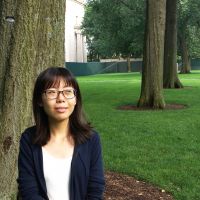 Xinyi MaMArch Degree, Architecture, 2016
Xinyi MaMArch Degree, Architecture, 2016Xinyi Ma is a current graduate student at MIT studying architecture design. She received a BA in Arts and BS in Civil Engineering from Lafayette College. The two fields of study constantly weave into her architectural thinking and create dialogues between form and structure.
Xinyi Ma
MArch Degree, Architecture, 2016
Xinyi Ma is a current graduate student at MIT studying architecture design. She received a BA in Arts and BS in Civil Engineering from Lafayette College. The two fields of study constantly weave into her architectural thinking and create dialogues between form and structure.
Recent Projects:
Contact:

-
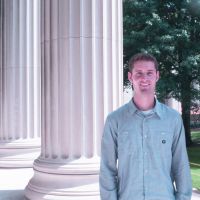 Nathan BrownPhD Degree, Architecture, 2016
Nathan BrownPhD Degree, Architecture, 2016
Next affiliation: Assistant Professor at Penn State UniversityNathan Brown is a Ph.D. student in Building Technology at MIT, where he earned an SMBT degree in 2016. His research seeks to understand how structural considerations interact with other architectural performance criteria in conceptual design. Nathan earned a BSE in Civil and Environmental Engineering at Princeton University, where he studied both architecture and structural engineering, and has also worked on building energy retrofit projects for Elevate Energy in Chicago.
Nathan Brown
PhD Degree, Architecture, 2016
Next affiliation: Assistant Professor at Penn State UniversityNathan Brown is a Ph.D. student in Building Technology at MIT, where he earned an SMBT degree in 2016. His research seeks to understand how structural considerations interact with other architectural performance criteria in conceptual design. Nathan earned a BSE in Civil and Environmental Engineering at Princeton University, where he studied both architecture and structural engineering, and has also worked on building energy retrofit projects for Elevate Energy in Chicago.
Recent Projects:
Publications:
Recent Blog Posts:
Contact:

-
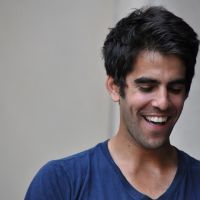 Sayjel PatelResearch Fellow, MIT-SUTD Collaboration, 2016
Sayjel PatelResearch Fellow, MIT-SUTD Collaboration, 2016
Next affiliation: SUTDSayjel (MIT MArch '15) is a Research Associtate with the MIT-SUTD Collaboration. A architectural designer and creative coder, Sayjel's research with Digital Structure expands the concept 3D Sampling: a design paradigm for applying 3D scans to the practice of design modelling, inspired by sample-based music. Sayjel is co-founder and former president of MIT CodeKitchen, a student group that seeks to expand code literacy within the MIT School of Architecture and Planning. Previously Sayjel was a visiting scholar with Mark Burry at the Royal Melbourne Institute of Technology (RMIT) Design Research Insitute where he developed prototype 3D modeling applications for client-architect briefing, and was an architectural designer for a number of international offices in Toronto, New York, Los Angeles, and Vienna. Sayjel's design work has addressed a range of topics and issues: from healthcare in the informal world, to 3D printing on Mars, and everything and anything in between.
Sayjel Patel
Research Fellow, MIT-SUTD Collaboration, 2016
Next affiliation: SUTDSayjel (MIT MArch '15) is a Research Associtate with the MIT-SUTD Collaboration. A architectural designer and creative coder, Sayjel's research with Digital Structure expands the concept 3D Sampling: a design paradigm for applying 3D scans to the practice of design modelling, inspired by sample-based music. Sayjel is co-founder and former president of MIT CodeKitchen, a student group that seeks to expand code literacy within the MIT School of Architecture and Planning. Previously Sayjel was a visiting scholar with Mark Burry at the Royal Melbourne Institute of Technology (RMIT) Design Research Insitute where he developed prototype 3D modeling applications for client-architect briefing, and was an architectural designer for a number of international offices in Toronto, New York, Los Angeles, and Vienna. Sayjel's design work has addressed a range of topics and issues: from healthcare in the informal world, to 3D printing on Mars, and everything and anything in between.
Recent Projects:
Publications:
Contact:

-
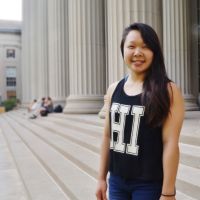 Chrystal ChernBS Degree, Mechanical Engineering, 2016
Chrystal ChernBS Degree, Mechanical Engineering, 2016
Next affiliation: Simpson Gumpertz & HegerChrystal studies mechanical engineering with a concentration on structures and sustainability. Chrystal is interested in holistic building design and optimizing the effect of buildings on community and environment through their form, structure, and envelope. Chrystal is passionate about understanding the technical aspects and engineering methods of building structures and envelopes. Chrystal is a former gymnast and her favorite things are friendship, learning, and dance.
Chrystal Chern
BS Degree, Mechanical Engineering, 2016
Next affiliation: Simpson Gumpertz & HegerChrystal studies mechanical engineering with a concentration on structures and sustainability. Chrystal is interested in holistic building design and optimizing the effect of buildings on community and environment through their form, structure, and envelope. Chrystal is passionate about understanding the technical aspects and engineering methods of building structures and envelopes. Chrystal is a former gymnast and her favorite things are friendship, learning, and dance.
Recent Projects:
Contact:

-
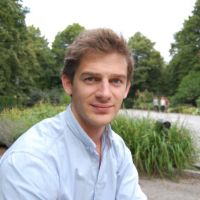 Daniel AkessonVisiting Researcher, Architecture, 2016
Daniel AkessonVisiting Researcher, Architecture, 2016
Next affiliation: Lund UniversityDaniel Akesson is a graduate student in structural mechanics from Lund university. The context of his research is a need for an improved conceptual structural design toolbox for designers, architects and engineers. His research seeks to develop new such tools that can help the user understand the structural behavior of a structure, or generate new structurally well performing design alternatives. Daniel is currently a visiting student at Building Technology at MIT.
Daniel Akesson
Visiting Researcher, Architecture, 2016
Next affiliation: Lund UniversityDaniel Akesson is a graduate student in structural mechanics from Lund university. The context of his research is a need for an improved conceptual structural design toolbox for designers, architects and engineers. His research seeks to develop new such tools that can help the user understand the structural behavior of a structure, or generate new structurally well performing design alternatives. Daniel is currently a visiting student at Building Technology at MIT.
Contact:

-
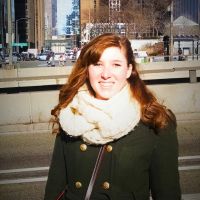 Jessica DukeMEng Degree, Civil and Environmental Engineering, 2016
Jessica DukeMEng Degree, Civil and Environmental Engineering, 2016
Next affiliation: LeMessurier ConsultantsJessica Duke is a graduate student in Structural Mechanics and Design at MIT. Her thesis aims to understand how the constraints natural ventilation, specifically natural ventilation within atriums, affects the structural performance of buildings. Jessica earned a BS in Civil and Environmental Engineernig from Cornell University. Jessica also works as a project engineer for an energy engineering firm in Needham, MA.
Jessica Duke
MEng Degree, Civil and Environmental Engineering, 2016
Next affiliation: LeMessurier ConsultantsJessica Duke is a graduate student in Structural Mechanics and Design at MIT. Her thesis aims to understand how the constraints natural ventilation, specifically natural ventilation within atriums, affects the structural performance of buildings. Jessica earned a BS in Civil and Environmental Engineernig from Cornell University. Jessica also works as a project engineer for an energy engineering firm in Needham, MA.
Contact:

-
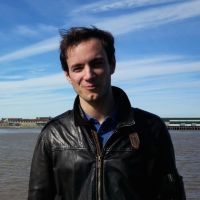 Ben JacotMEng Degree, Civil and Environmental Engineering, 2016
Ben JacotMEng Degree, Civil and Environmental Engineering, 2016Ben is a graduate student in Structural Mechanics and Design at MIT. He holds a M.Sc. from École des Ponts in Paris and worked for one year at SOM San Francisco and Foster+Partners London. He has always been passionate about skyscrapers. His research focuses on generating three-dimensional Michell structures in the prospect of enhancing lateral systems for tall buildings.
Ben Jacot
MEng Degree, Civil and Environmental Engineering, 2016
Ben is a graduate student in Structural Mechanics and Design at MIT. He holds a M.Sc. from École des Ponts in Paris and worked for one year at SOM San Francisco and Foster+Partners London. He has always been passionate about skyscrapers. His research focuses on generating three-dimensional Michell structures in the prospect of enhancing lateral systems for tall buildings.
Contact:

-
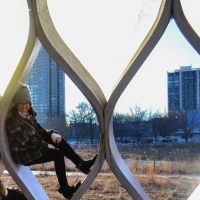 Melody TanMEng Degree, Civil and Environmental Engineering, 2016
Melody TanMEng Degree, Civil and Environmental Engineering, 2016
Next affiliation: Robert Silman and AssociatesMelody Tan is currently a graduate student in the Structural Mechanics and Design Master of Engineering program at MIT. Her master’s thesis will focus on quantifying and integrating structural steel constructability into a multi-objective approach to steel floor framing design. Melody received her BSE degree in Civil and Environmental Engineering at Princeton University in 2013 and has previously worked at a structural design firm in New York City. She hopes to return to structural practice upon her graduation in June 2016.
Melody Tan
MEng Degree, Civil and Environmental Engineering, 2016
Next affiliation: Robert Silman and AssociatesMelody Tan is currently a graduate student in the Structural Mechanics and Design Master of Engineering program at MIT. Her master’s thesis will focus on quantifying and integrating structural steel constructability into a multi-objective approach to steel floor framing design. Melody received her BSE degree in Civil and Environmental Engineering at Princeton University in 2013 and has previously worked at a structural design firm in New York City. She hopes to return to structural practice upon her graduation in June 2016.
Contact:
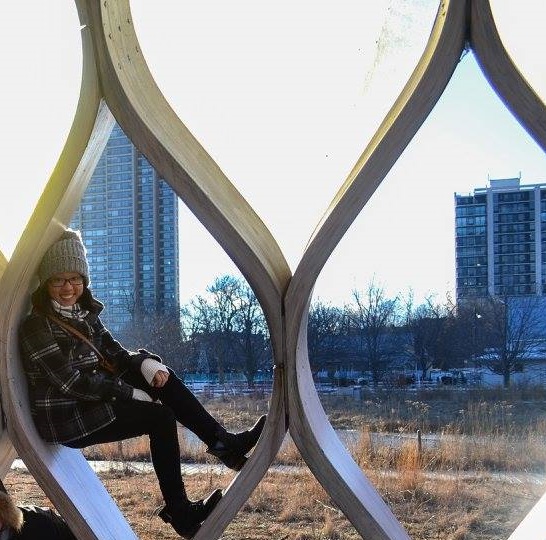
-
 Crystal WangBS Degree, Electrical Engineering and Computer Science, 2016
Crystal WangBS Degree, Electrical Engineering and Computer Science, 2016Crystal Wang is a current undergraduate at MIT studying electrical engineering and computer science, with some math on the side. Her work in the Digital Structures group focuses on the strength of folded forms in an architectural context as well as design tools to create structural origami-inspired designs. On the side, she enjoys folding origami, metalworking, cooking, technical ropework, and spinning, and breathing fire.
Crystal Wang
BS Degree, Electrical Engineering and Computer Science, 2016
Crystal Wang is a current undergraduate at MIT studying electrical engineering and computer science, with some math on the side. Her work in the Digital Structures group focuses on the strength of folded forms in an architectural context as well as design tools to create structural origami-inspired designs. On the side, she enjoys folding origami, metalworking, cooking, technical ropework, and spinning, and breathing fire.
Contact:
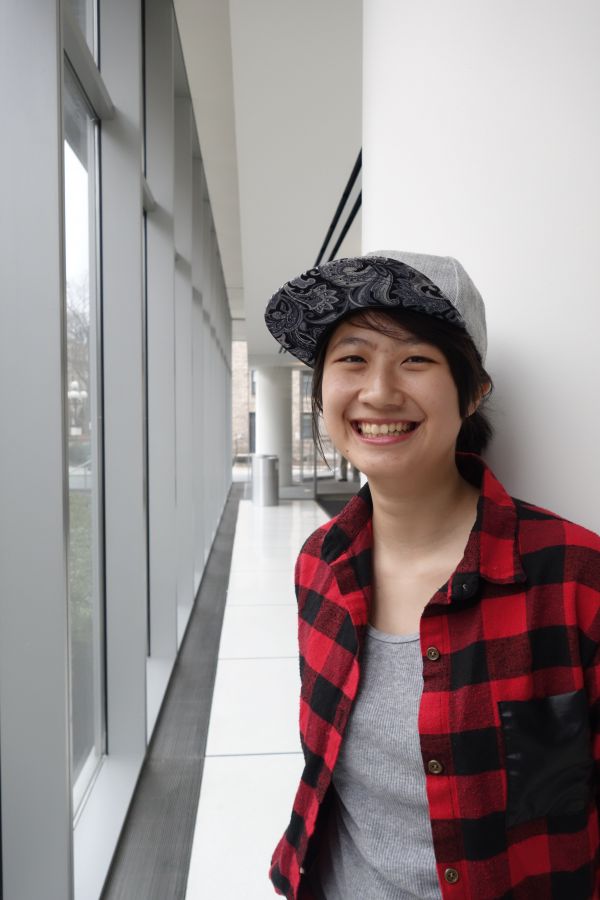
-
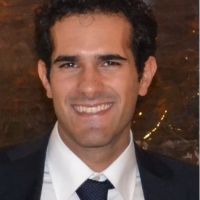 Leonardo TodiscoVisiting Researcher, Architecture, 2015
Leonardo TodiscoVisiting Researcher, Architecture, 2015
Next affiliation: Technical University of MadridLeonardo is a chartered Structural Engineer and a PhD Candidate at the Technical University of Madrid, Spain. He received a B.Sc. and a M.Sc. in Civil Engineering from the Technical University of Bari, Italy. After working as graduate structural engineer in Italy and Spain, he went back to academia and got a second masters degree in Structural Engineering from the Technical University of Madrid, Spain. During his studies, as a visiting student, he spent several months at ILEK, University of Stuttgart (Germany), at the Technical University of Valencia (Spain) and, during his PhD, at the Massachusetts Institute of Technology (USA). His research interests cover mainly three different areas: conceptual design of structures, shear strength of reinforced concrete members and analysis of masonry structures. In 2013 he co-founded Apuliabase, a startup working on the protection of existing masonry structures.
Leonardo Todisco
Visiting Researcher, Architecture, 2015
Next affiliation: Technical University of MadridLeonardo is a chartered Structural Engineer and a PhD Candidate at the Technical University of Madrid, Spain. He received a B.Sc. and a M.Sc. in Civil Engineering from the Technical University of Bari, Italy. After working as graduate structural engineer in Italy and Spain, he went back to academia and got a second masters degree in Structural Engineering from the Technical University of Madrid, Spain. During his studies, as a visiting student, he spent several months at ILEK, University of Stuttgart (Germany), at the Technical University of Valencia (Spain) and, during his PhD, at the Massachusetts Institute of Technology (USA). His research interests cover mainly three different areas: conceptual design of structures, shear strength of reinforced concrete members and analysis of masonry structures. In 2013 he co-founded Apuliabase, a startup working on the protection of existing masonry structures.
Recent Projects:
Publications:
Contact:
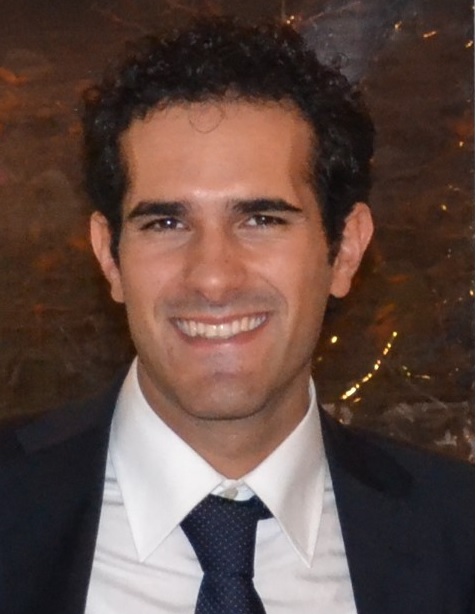
-
 Aurimas BukauskasBSA Degree, Architecture, 2015
Aurimas BukauskasBSA Degree, Architecture, 2015
Next affiliation: Funded year of research travel through the Carroll L. Wilson AwardAurimas Bukauskas is a recent MIT graduate with a Bachelors of Science in Architecture, focusing in Building Technology. Aurimas is currently travelling and conducting research on low-carbon whole-timber structural systems in the UK, New Zealand, and Colombia.
Aurimas Bukauskas
BSA Degree, Architecture, 2015
Next affiliation: Funded year of research travel through the Carroll L. Wilson AwardAurimas Bukauskas is a recent MIT graduate with a Bachelors of Science in Architecture, focusing in Building Technology. Aurimas is currently travelling and conducting research on low-carbon whole-timber structural systems in the UK, New Zealand, and Colombia.
Recent Projects:
Publications:
Contact:
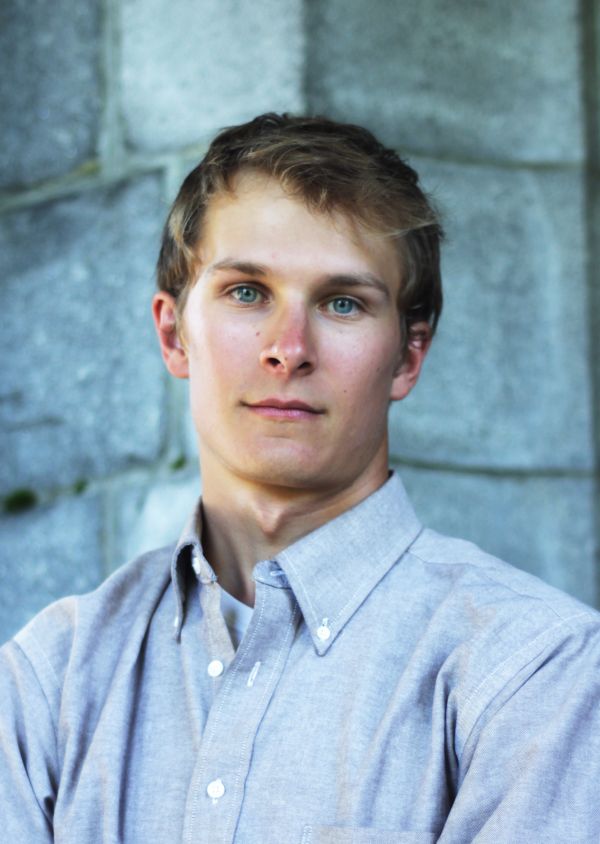
-
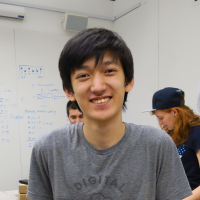 Mitchell GuBS Degree, Electrical Engineering and Computer Science, 2015
Mitchell GuBS Degree, Electrical Engineering and Computer Science, 2015Mitchell Gu is a current undergraduate at MIT studying some combination of mechanical engineering, electrical engineering, and computer science. He is an enthusiastic maker of many things electromechanical but is also excited about exploring architectural concepts while in the Digital Structures group. With a background in hobbyist 3D printer building, Mitchell hopes to explore methods of 3D printing in a layer-free, structurally optimized way while building on the group's previous work. He also has a penchant for codingfor electronics and robotics, and he looks forward to generating toolpaths for the group's six axis robotic arm.
In spare time, Mitchell enjoys listening to rock (particularly Muse), playing piano or guitar, rollerblading, skiing, and traveling.
Mitchell Gu
BS Degree, Electrical Engineering and Computer Science, 2015
Mitchell Gu is a current undergraduate at MIT studying some combination of mechanical engineering, electrical engineering, and computer science. He is an enthusiastic maker of many things electromechanical but is also excited about exploring architectural concepts while in the Digital Structures group. With a background in hobbyist 3D printer building, Mitchell hopes to explore methods of 3D printing in a layer-free, structurally optimized way while building on the group's previous work. He also has a penchant for codingfor electronics and robotics, and he looks forward to generating toolpaths for the group's six axis robotic arm.
In spare time, Mitchell enjoys listening to rock (particularly Muse), playing piano or guitar, rollerblading, skiing, and traveling.
Recent Projects:
Contact:

-
 Juney LeeMEng Degree, Civil and Environmental Engineering, 2015
Juney LeeMEng Degree, Civil and Environmental Engineering, 2015
Next affiliation: PhD Candidate at ETH Zurich, SwitzerlandTrained academically and professionally as both an architect and a structural engineer, Juney seeks to discover new methods of architectural thinking, designing and making through creative exploration of structural engineering ideas. Utilizing geometric and graphical computation as the language of the discipline in-between disciplines, Juney hopes to develop clearer dialogue between the conventionally disparate but increasingly more symbiotic disciplines in both academia and practice.
Previously, Juney has worked at a number of renowned design offices (5 years of professional experience) including Skidmore, Owings & Merrill (San Francisco and Chicago), Grimshaw Architects (New York) and TriPyramid Structures Inc. (Westford, MA). Juney has collaborated with designers, architects and engineers on a wide range of projects including high-rise towers, private residential homes, a state of the art museum, masterplanning of cities, and design-fabrication of custom, steel architectural hardware.
Juney has a Bachelor of Arts degree in architecture and a minor degree in structural engineering from University of California at Berkeley. After receiving Master of Architecture degree from MIT in 2014, Juney continued his interdisciplinary education and research at MIT's Department of Civil and Environmental Engineering and completed Master of Engineering (Structural) degree in 2015.
In fall of 2015, Juney will be joining the Block Research Group of ETH Zürich, Switzerland as a PhD candidate in Architecture and Technology.
Juney Lee
MEng Degree, Civil and Environmental Engineering, 2015
Next affiliation: PhD Candidate at ETH Zurich, SwitzerlandTrained academically and professionally as both an architect and a structural engineer, Juney seeks to discover new methods of architectural thinking, designing and making through creative exploration of structural engineering ideas. Utilizing geometric and graphical computation as the language of the discipline in-between disciplines, Juney hopes to develop clearer dialogue between the conventionally disparate but increasingly more symbiotic disciplines in both academia and practice.
Previously, Juney has worked at a number of renowned design offices (5 years of professional experience) including Skidmore, Owings & Merrill (San Francisco and Chicago), Grimshaw Architects (New York) and TriPyramid Structures Inc. (Westford, MA). Juney has collaborated with designers, architects and engineers on a wide range of projects including high-rise towers, private residential homes, a state of the art museum, masterplanning of cities, and design-fabrication of custom, steel architectural hardware.
Juney has a Bachelor of Arts degree in architecture and a minor degree in structural engineering from University of California at Berkeley. After receiving Master of Architecture degree from MIT in 2014, Juney continued his interdisciplinary education and research at MIT's Department of Civil and Environmental Engineering and completed Master of Engineering (Structural) degree in 2015.
In fall of 2015, Juney will be joining the Block Research Group of ETH Zürich, Switzerland as a PhD candidate in Architecture and Technology.
Recent Projects:
Publications:
Contact:

-
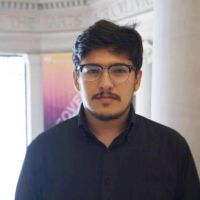 Jonathas FelipeVisiting Researcher, Architecture, 2015
Jonathas FelipeVisiting Researcher, Architecture, 2015Jonathas is a visiting student from Brazil (Mossoró) at MIT with Civil Engineering background currently developing tools for multi objective optimization, sampling of design spaces, and other auxiliary tools for helping in parametric modeling of structures. He is interested in how structures behave, form-finding, and in developing computation tools for structural design and optimization. He also interested in 3D printing and augmented reality technologies and also in developing structural analysis apps for mobile devices (mainly Android devices). During his free time, he enjoys playing guitar, listening to music, and discovering new technologies to use in structural analysis teaching.
Jonathas Felipe
Visiting Researcher, Architecture, 2015
Jonathas is a visiting student from Brazil (Mossoró) at MIT with Civil Engineering background currently developing tools for multi objective optimization, sampling of design spaces, and other auxiliary tools for helping in parametric modeling of structures. He is interested in how structures behave, form-finding, and in developing computation tools for structural design and optimization. He also interested in 3D printing and augmented reality technologies and also in developing structural analysis apps for mobile devices (mainly Android devices). During his free time, he enjoys playing guitar, listening to music, and discovering new technologies to use in structural analysis teaching.
Recent Projects:
Publications:

-
 Stavros TseranidisSM Degree, Center for Computational Engineering, 2015
Stavros TseranidisSM Degree, Center for Computational Engineering, 2015
Next affiliation: Skidmore, Owings & MerrillStavros Tseranidis earned a SM in Computation for Design and Optimization (CDO) from MIT. For his research at MIT, with Prof. Caitlin Mueller, he developed surrogate modelling frameworks for the design of architectural and civil structures with a main focus on utilizing them for large-scale projects. During his studies at MIT, he has also been a teaching assistant in the “Smart Structures” course by Prof. Jerome Connor and in the core civil engineering course “Mechanics of Structures and Soils” with Dr. Pierre Ghisbain. He holds a degree in civil engineering from the Aristotle University of Thessaloniki (AUTh). For his research there he worked on structural health monitoring systems under the supervision of Prof. Demos Angelides. He is a chartered civil engineer by the technical chamber of Greece. His interests span a wide range from structural optimization to computational algorithms and big data.
Stavros Tseranidis
SM Degree, Center for Computational Engineering, 2015
Next affiliation: Skidmore, Owings & MerrillStavros Tseranidis earned a SM in Computation for Design and Optimization (CDO) from MIT. For his research at MIT, with Prof. Caitlin Mueller, he developed surrogate modelling frameworks for the design of architectural and civil structures with a main focus on utilizing them for large-scale projects. During his studies at MIT, he has also been a teaching assistant in the “Smart Structures” course by Prof. Jerome Connor and in the core civil engineering course “Mechanics of Structures and Soils” with Dr. Pierre Ghisbain. He holds a degree in civil engineering from the Aristotle University of Thessaloniki (AUTh). For his research there he worked on structural health monitoring systems under the supervision of Prof. Demos Angelides. He is a chartered civil engineer by the technical chamber of Greece. His interests span a wide range from structural optimization to computational algorithms and big data.
Recent Projects:
Publications:
Contact:
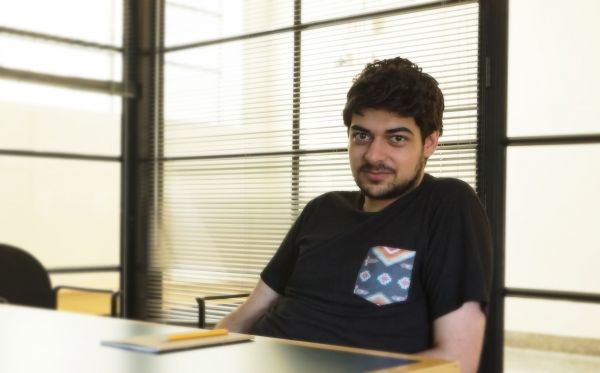
-
 Abbi HornMEng Degree, Civil and Environmental Engineering, 2015
Abbi HornMEng Degree, Civil and Environmental Engineering, 2015
Next affiliation: Weidlinger Associates, Inc.Abbi completed here Master of Engineering degree in High Performance Structures in May 2015. At MIT, her research focused on the integration of constructability and structural performance in conceptual structural design. Prior to her studies at MIT, Abbi completed her undergraduate work at Cornell University in 2009 before working in construction management for five years. Abbi is now working as a structural engineer at Weidlinger Associates, Inc. in New York City.
Abbi Horn
MEng Degree, Civil and Environmental Engineering, 2015
Next affiliation: Weidlinger Associates, Inc.Abbi completed here Master of Engineering degree in High Performance Structures in May 2015. At MIT, her research focused on the integration of constructability and structural performance in conceptual structural design. Prior to her studies at MIT, Abbi completed her undergraduate work at Cornell University in 2009 before working in construction management for five years. Abbi is now working as a structural engineer at Weidlinger Associates, Inc. in New York City.
Recent Projects:
Publications:
Contact:
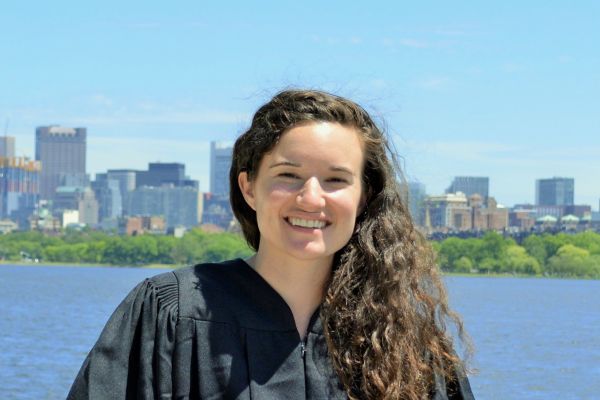
-
 Andy SmithVisiting Researcher, Civil Engineering, 2015
Andy SmithVisiting Researcher, Civil Engineering, 2015
Next affiliation: Cambridge UniversityAndy is currently a fourth-year undergraduate studying Engineering at Selwyn College, Cambridge, UK. He joined the Digital Structures research group in 2014 while taking part in a year-long exchange programme to MIT. Andy got involved with a wide range of projects, including helping out with design and testing for the Collier Memorial and the Paperwave Pavilion. During 2015 spring semester he also undertook a UROP supervised by Caitlin Mueller investigating a new computational method for carrying out early-stage design of buildings.
Andy Smith
Visiting Researcher, Civil Engineering, 2015
Next affiliation: Cambridge UniversityAndy is currently a fourth-year undergraduate studying Engineering at Selwyn College, Cambridge, UK. He joined the Digital Structures research group in 2014 while taking part in a year-long exchange programme to MIT. Andy got involved with a wide range of projects, including helping out with design and testing for the Collier Memorial and the Paperwave Pavilion. During 2015 spring semester he also undertook a UROP supervised by Caitlin Mueller investigating a new computational method for carrying out early-stage design of buildings.
Recent Projects:
Contact:

-
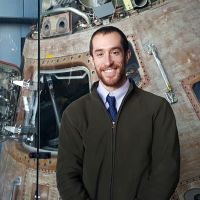 Samuel WaldPhD Degree, Aeronautics & Astronautics
Samuel WaldPhD Degree, Aeronautics & AstronauticsSamuel is an aerospace engineer and designer who is guided by his passion for space exploration, human habitation, and system optimization. He completed his undergraduate studies at Harvard and practiced as a mechanical design engineer before completing his MS in aerospace engineering. His master thesis investigated the value of in-space manufacturing, recycling, and reconfiguration of components for crewed Mars missions. At MIT, he hopes to develop the space habitation design tools to inform decisions impacting system evolvability and flexibility under uncertainty.
Samuel Wald
PhD Degree, Aeronautics & Astronautics
Samuel is an aerospace engineer and designer who is guided by his passion for space exploration, human habitation, and system optimization. He completed his undergraduate studies at Harvard and practiced as a mechanical design engineer before completing his MS in aerospace engineering. His master thesis investigated the value of in-space manufacturing, recycling, and reconfiguration of components for crewed Mars missions. At MIT, he hopes to develop the space habitation design tools to inform decisions impacting system evolvability and flexibility under uncertainty.
Recent Projects:
Contact:

-
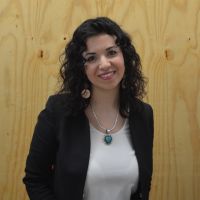 Valentina SuminiResearch Fellow, Civil and Environmental Engineering
Valentina SuminiResearch Fellow, Civil and Environmental EngineeringSumini's research aims to explore form finding and structural optimization strategies for deep space exploration habitats on extraplanetary surfaces such as the Moon and Mars. New computational design methods for space surface habitats, that respond to architectural, structural, functional and physical requirements, are explored, offering new ways to support future space exploration.
Valentina Sumini
Research Fellow, Civil and Environmental Engineering
Sumini's research aims to explore form finding and structural optimization strategies for deep space exploration habitats on extraplanetary surfaces such as the Moon and Mars. New computational design methods for space surface habitats, that respond to architectural, structural, functional and physical requirements, are explored, offering new ways to support future space exploration.
Recent Projects:
Publications:
Contact:

news
-
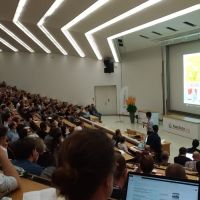 Yijiang Huang presents at ROB|ARCH 2018 in Zurich2018-09-14
Yijiang Huang presents at ROB|ARCH 2018 in Zurich2018-09-14Yijiang Huang presented his paper, Robotic Extrusion of Architectural Structures with Nonstandard Topology, co-authored by Josephine Carstensen, Lavender Tessmer, and Caitlin Mueller, at the 2018 Robotic Fabrication in Architecture, Art, and Design 2018 Conference held at ETH Zurich. The presentation marked the first public presentation of the Choreo robotic path planning platform.
Yijiang Huang presents at ROB|ARCH 2018 in Zurich
2018-09-14
Yijiang Huang presented his paper, Robotic Extrusion of Architectural Structures with Nonstandard Topology, co-authored by Josephine Carstensen, Lavender Tessmer, and Caitlin Mueller, at the 2018 Robotic Fabrication in Architecture, Art, and Design 2018 Conference held at ETH Zurich. The presentation marked the first public presentation of the Choreo robotic path planning platform.
Related group members:

-
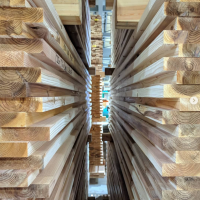 Paul Mayencourt embarks on month-long research trip to Japan2018-08-01, Tags: timber
Paul Mayencourt embarks on month-long research trip to Japan2018-08-01, Tags: timberPaul Mayencourt is spending the month of August in Japan for a research fellowship with the Japanese Association for the Promotion of Science (JSPS). His travels will include study and documentation of wood structures, architecture ,and furniture. For a glimpse into his trip, check out his Instagram.
Paul Mayencourt embarks on month-long research trip to Japan
2018-08-01
Paul Mayencourt is spending the month of August in Japan for a research fellowship with the Japanese Association for the Promotion of Science (JSPS). His travels will include study and documentation of wood structures, architecture ,and furniture. For a glimpse into his trip, check out his Instagram.
Related group members:
Tags:

-
 MIT hosts IASS 2018 Symposium, Creativity in Structural Design2018-07-16
MIT hosts IASS 2018 Symposium, Creativity in Structural Design2018-07-16MIT Architecture and Civil and Environmental Engineering host the 2018 Symposium of the International Association of Shell and Spatial Structures, with the theme of Creativity in Structural Design. Caitlin Mueller is chair the Organizing Committee for the event, along with Sigrid Adriaenssens, Bill Baker, John Ochsendorf, and John Abel as co-chairs. The week-long event welcomes more than 600 participants from academia and practice, architecture and engineering, and more than 40 countries to the iconic Kresge Auditorium on the MIT campus. More than 450 papers are presented in technical sessions during the week, along with 10 plenary talks and pre-symposium workshops. Digital Structures researchers and alumni are well represented at the event through paper presentations and workshops, as well as serving as volunteers in a wide range of tasks to keep the event running smoothly.
MIT hosts IASS 2018 Symposium, Creativity in Structural Design
2018-07-16
MIT Architecture and Civil and Environmental Engineering host the 2018 Symposium of the International Association of Shell and Spatial Structures, with the theme of Creativity in Structural Design. Caitlin Mueller is chair the Organizing Committee for the event, along with Sigrid Adriaenssens, Bill Baker, John Ochsendorf, and John Abel as co-chairs. The week-long event welcomes more than 600 participants from academia and practice, architecture and engineering, and more than 40 countries to the iconic Kresge Auditorium on the MIT campus. More than 450 papers are presented in technical sessions during the week, along with 10 plenary talks and pre-symposium workshops. Digital Structures researchers and alumni are well represented at the event through paper presentations and workshops, as well as serving as volunteers in a wide range of tasks to keep the event running smoothly.
Related blog posts:
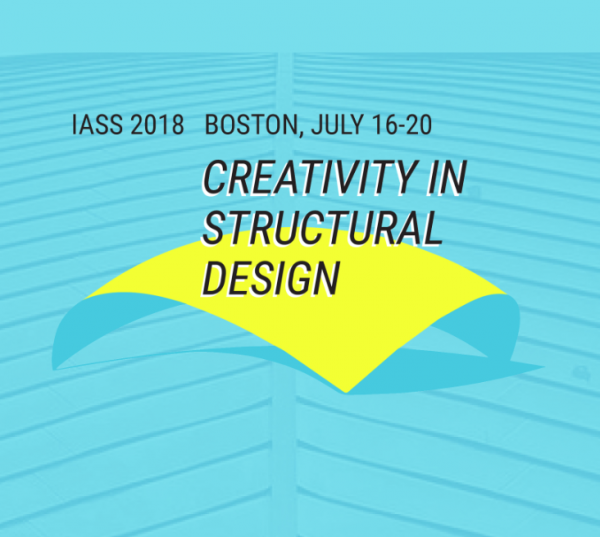
-
 Caitlin delivers keynote talk at ACM Symposium on Computational Fabrication 20182018-06-19
Caitlin delivers keynote talk at ACM Symposium on Computational Fabrication 20182018-06-19Caitlin Mueller delivered a keynote address entitled Creativity in Performance-Driven Design at the 2018 Symposium on Computational Fabrication hosted at the MIT Center for Bits and Atoms.
Caitlin delivers keynote talk at ACM Symposium on Computational Fabrication 2018
2018-06-19
Caitlin Mueller delivered a keynote address entitled Creativity in Performance-Driven Design at the 2018 Symposium on Computational Fabrication hosted at the MIT Center for Bits and Atoms.
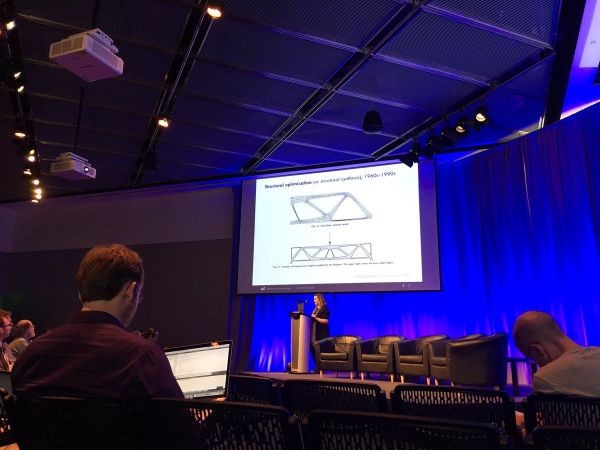
-
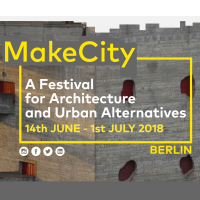 Caitlin Mueller speaks on panel for MakeCity Berlin2018-06-15
Caitlin Mueller speaks on panel for MakeCity Berlin2018-06-15As part of a special panel entitled Traditional meets new: Technologies / Materials, Caitlin Mueller spoke and discussed her resesarch on structures, materials, and fabrication.
Caitlin Mueller speaks on panel for MakeCity Berlin
2018-06-15
As part of a special panel entitled Traditional meets new: Technologies / Materials, Caitlin Mueller spoke and discussed her resesarch on structures, materials, and fabrication.
Related group members:

-
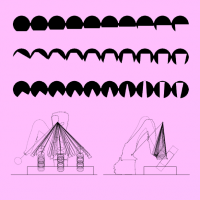 New MIT class on Design for Robotic Assembly presents final projects2018-05-21
New MIT class on Design for Robotic Assembly presents final projects2018-05-21Caitlin Mueller, Justin Lavallee, and Yijiang Huang co-taught a new research seminar focused on design for robotic assembly. A group of 12 students from Architecture, Civil and Environmental Engineering, and Mechanical Engineering embarked on a range of design and research projects over the course in the semester, culminating in three final presentations at the end of the term. The projects included investigations into robotic foam cutting of molds for aluminum casting, parametric concrete casting with robotic motion, and a Calder-inspired dynamic mobile-making process.
Work in image by Lavender Tessmer, Kevin Marblestone, and Thuy Le.
New MIT class on Design for Robotic Assembly presents final projects
2018-05-21
Caitlin Mueller, Justin Lavallee, and Yijiang Huang co-taught a new research seminar focused on design for robotic assembly. A group of 12 students from Architecture, Civil and Environmental Engineering, and Mechanical Engineering embarked on a range of design and research projects over the course in the semester, culminating in three final presentations at the end of the term. The projects included investigations into robotic foam cutting of molds for aluminum casting, parametric concrete casting with robotic motion, and a Calder-inspired dynamic mobile-making process.
Work in image by Lavender Tessmer, Kevin Marblestone, and Thuy Le.
Related group members:

-
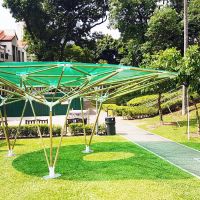 Felix Amtsberg's Bamboo Pavillion "Sombra Verde" opened in Singapore2018-05-09, Tags: 3d-printing additive-manufacturing digital-manufacturing fabrication
Felix Amtsberg's Bamboo Pavillion "Sombra Verde" opened in Singapore2018-05-09, Tags: 3d-printing additive-manufacturing digital-manufacturing fabricationThe bamboo pavilion “Sombra Verde” combines digital fabrication technology (I.E. 3D-printing) with natural grown resources in a spatial grid structure. Visual sensing digitizes the section geometry of each bamboo pole, which is used in two ways.
-
The bamboo poles are placed according their load-carrying capacity
-
The specific section geometry informs the digital model to fabricate a bespoke dowel system
Conventional 3D-Printers on PLA base materialize the 36 joints and 234 connectors using eco-friendly PLA and merge natural and "digital" materiality.
The project, which was developed and designed by Felix Amtsberg, Felix Raspall and Carlos Banon of AIRLab, can be visited in Duxton Plain Park until the 15th of June.
Felix Amtsberg's Bamboo Pavillion "Sombra Verde" opened in Singapore
2018-05-09
The bamboo pavilion “Sombra Verde” combines digital fabrication technology (I.E. 3D-printing) with natural grown resources in a spatial grid structure. Visual sensing digitizes the section geometry of each bamboo pole, which is used in two ways.
-
The bamboo poles are placed according their load-carrying capacity
-
The specific section geometry informs the digital model to fabricate a bespoke dowel system
Conventional 3D-Printers on PLA base materialize the 36 joints and 234 connectors using eco-friendly PLA and merge natural and "digital" materiality.
The project, which was developed and designed by Felix Amtsberg, Felix Raspall and Carlos Banon of AIRLab, can be visited in Duxton Plain Park until the 15th of June.
Related group members:
Tags:

-
-
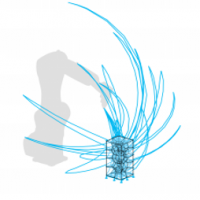 Yijiang Huang presented a poster at New England Symposium on Graphics2018-04-29, Tags: fabrication additive-manufacturing robotic-fabrication
Yijiang Huang presented a poster at New England Symposium on Graphics2018-04-29, Tags: fabrication additive-manufacturing robotic-fabricationYijiang Huang is presenting the Choreo robotic assembly planning platform at the New England Symposium on Graphics, at MIT's Stata Center on April 29, 2018.
Yijiang Huang presented a poster at New England Symposium on Graphics
2018-04-29
Yijiang Huang is presenting the Choreo robotic assembly planning platform at the New England Symposium on Graphics, at MIT's Stata Center on April 29, 2018.
Related projects:
Related group members:
Tags:
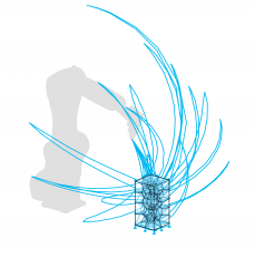
older news
-
 Digital Structures offers a workshop on active bending simulation at AAG 20182018-04-25, Tags: computation fabrication design-tool form-finding bending-active shaping
Digital Structures offers a workshop on active bending simulation at AAG 20182018-04-25, Tags: computation fabrication design-tool form-finding bending-active shapingThe workshop will explore the design of bending-active structures with variable cross-sections to fit a target design shape. Over the two days, the participants will use computational form-finding tools for bending-active structures, and design and build an arc lamp. The participants will learn state-of-the-art methods for simulating bending-active behavior, and for the control and optimization of their equilibrium shapes. These methods can be applied to the design of large scale bending-active structures such as elastic gridshells. The workshop is appropriate for all levels of expertise with bending-active simulations; we will provide the participants with computational tools and workflows to successfully design their own sculptures.
Register here!
Digital Structures offers a workshop on active bending simulation at AAG 2018
2018-04-25
The workshop will explore the design of bending-active structures with variable cross-sections to fit a target design shape. Over the two days, the participants will use computational form-finding tools for bending-active structures, and design and build an arc lamp. The participants will learn state-of-the-art methods for simulating bending-active behavior, and for the control and optimization of their equilibrium shapes. These methods can be applied to the design of large scale bending-active structures such as elastic gridshells. The workshop is appropriate for all levels of expertise with bending-active simulations; we will provide the participants with computational tools and workflows to successfully design their own sculptures.
Register here!
Related group members:
Tags:

-
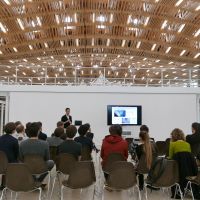 Yijiang Huang presents at ITA, ETH Zurich2018-03-26, Tags: fabrication construction-planning
Yijiang Huang presents at ITA, ETH Zurich2018-03-26, Tags: fabrication construction-planningYijiang Huang is presenting his work on "Robotic assembly planning: towards construction-driven geometry guidance" at the Institute of Technology in Architecture (ITA), ETH Zurich on March 26, 2018. This talk is a part of the MAS Digital Fabrication Lecture Series.
Yijiang Huang presents at ITA, ETH Zurich
2018-03-26
Yijiang Huang is presenting his work on "Robotic assembly planning: towards construction-driven geometry guidance" at the Institute of Technology in Architecture (ITA), ETH Zurich on March 26, 2018. This talk is a part of the MAS Digital Fabrication Lecture Series.
Related projects:
Related group members:
Tags:

-
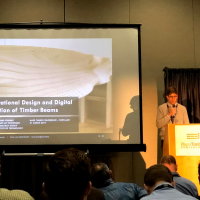 Paul Mayencourt presents at 2018 International Mass Timber Conference2018-03-21, Tags: conference digital-manufacturing optimization structural-optimization timber fabrication
Paul Mayencourt presents at 2018 International Mass Timber Conference2018-03-21, Tags: conference digital-manufacturing optimization structural-optimization timber fabricationPaul Mayencourt is presenting his work on "Digital Fabrication and Structural Optimization of Timber Beams" at the 2018 International Mass Timber Conference in Portland, Oregon on March 21, 2018. Demi Fang will also be attending the conference to represent Digital Structures.
Paul Mayencourt presents at 2018 International Mass Timber Conference
2018-03-21
Paul Mayencourt is presenting his work on "Digital Fabrication and Structural Optimization of Timber Beams" at the 2018 International Mass Timber Conference in Portland, Oregon on March 21, 2018. Demi Fang will also be attending the conference to represent Digital Structures.
Related projects:
Related group members:
Tags:

-
 Mohamed Ismail Presents at ACSA 20182018-03-17, Tags: conceptual-design conceptual-structural-design constructabililty design-tool shell-structures structural-optimization visualization
Mohamed Ismail Presents at ACSA 20182018-03-17, Tags: conceptual-design conceptual-structural-design constructabililty design-tool shell-structures structural-optimization visualizationMohamed presented his paper entitled "Resistance Through Form: Synthesis Structures in the Design of a Residential Architecture for Khartoum, Sudan" at the Association of Collegiate Schools of Architecture's (ACSA) 106th Annual Meeting in Denver, Colorado, on March 17th, 2018. He presented his paper in the session "Architecture of the other 99%? – Power, Economy, and the Dilemma of History", and then joined a panel discussion moderated by Professor Ole Fischer of the University of Utah.
Mohamed Ismail Presents at ACSA 2018
2018-03-17
Mohamed presented his paper entitled "Resistance Through Form: Synthesis Structures in the Design of a Residential Architecture for Khartoum, Sudan" at the Association of Collegiate Schools of Architecture's (ACSA) 106th Annual Meeting in Denver, Colorado, on March 17th, 2018. He presented his paper in the session "Architecture of the other 99%? – Power, Economy, and the Dilemma of History", and then joined a panel discussion moderated by Professor Ole Fischer of the University of Utah.
Related projects:
Related group members:
Tags:
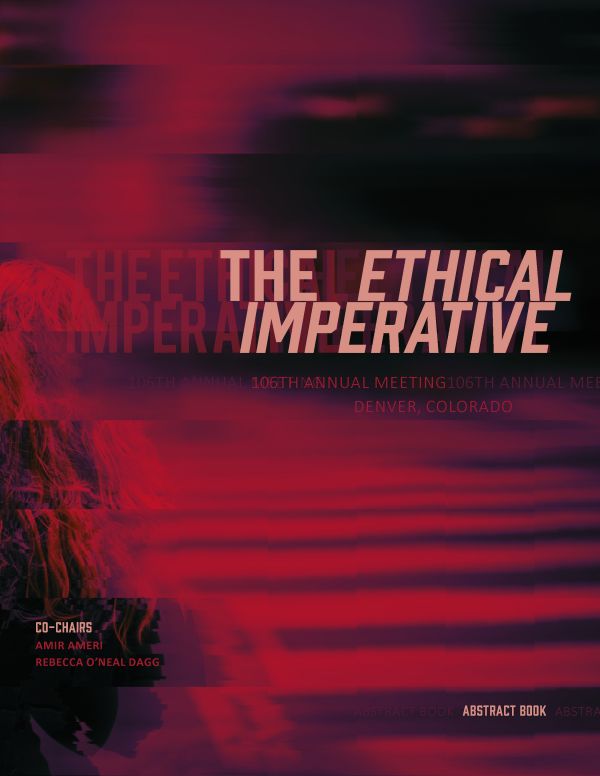
-
 Valentina Sumini and Caitlin Mueller present at Beyond the Cradle conference2018-03-10
Valentina Sumini and Caitlin Mueller present at Beyond the Cradle conference2018-03-10Valentina and Caitlin are speaking as part of a workshop on the Future of Space Architecture at the MIT Media Lab Beyond the Cradle conference, which focuses on envisioning a new space age.
Valentina Sumini and Caitlin Mueller present at Beyond the Cradle conference
2018-03-10
Valentina and Caitlin are speaking as part of a workshop on the Future of Space Architecture at the MIT Media Lab Beyond the Cradle conference, which focuses on envisioning a new space age.

-
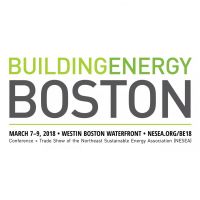 Caitlin Mueller and Paul Mayencourt present at NESEA Build Energy Boston2018-03-09, Tags: conceptual-design embodied-carbon
Caitlin Mueller and Paul Mayencourt present at NESEA Build Energy Boston2018-03-09, Tags: conceptual-design embodied-carbonCaitlin Mueller and Paul Mayencourt will present in a panel at the NESEA conference on March 9th on Material Choice and Climate Change on environmental impact of building materials.
Caitlin Mueller and Paul Mayencourt present at NESEA Build Energy Boston
2018-03-09
Caitlin Mueller and Paul Mayencourt will present in a panel at the NESEA conference on March 9th on Material Choice and Climate Change on environmental impact of building materials.
Related group members:
Tags:

-
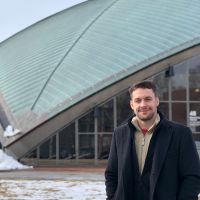 Felix Amtsberg joins the Digital Structures Group2018-02-13
Felix Amtsberg joins the Digital Structures Group2018-02-13For the new year we are joined by Felix Amtsberg, a postdoc focusing on robotic fabrication of load carrying structures and sensory informed production. Before landing in Boston, Felix was at the SUTD in Singapore and at TU Graz in Austria, originally hailing from Germany. Welcome, Felix!
Felix Amtsberg joins the Digital Structures Group
2018-02-13
For the new year we are joined by Felix Amtsberg, a postdoc focusing on robotic fabrication of load carrying structures and sensory informed production. Before landing in Boston, Felix was at the SUTD in Singapore and at TU Graz in Austria, originally hailing from Germany. Welcome, Felix!
Related group members:

-
 New class at MIT, Collaborating Across Disciplines: Architects and Engineers2018-02-06, Tags: collaboration
New class at MIT, Collaborating Across Disciplines: Architects and Engineers2018-02-06, Tags: collaborationCaitlin Mueller is offering a new reseach seminar class in the Spring 2018 semester at MIT called Collaborating Across Disciplines: Architects and Engineers (4.s42). Details below:
Design in the built environment necessarily entails collaboration across disciplines, especially when there are aspirations for innovation in geometry, materials, and construction technologies to support and contribute to an architectural vision. Indeed, many of the most significant achievements in buildings have been empowered by important and synthetic contributions from architects and structural engineers working together closely. In 4.s42, we will critically examine key characters in collaborations of these types, investigating their relationships, communication styles, tools, design processes, and legacies.
We will focus specifically on ambitious reinforced concrete architecture of the 1950s-1970s from around the world, which includes diverse formal development and structural innovation, from thin concrete shells to complex space frames to soaring spans. This time period also marks a fundamental shift in available tools and calculation methods for engineers, with the development of finite element analysis and related computational techniques. Our goal is to extract examples and principles of productive collaborations from this context and consider how they might be applied going forward.
Each student will take on an individual architect-engineer pairing to study in detail in a semester-long research project. Possible pairings include Eero Saarinen and Abba Tor, Louis Kahn and August Komendant, Kenzo Tange and Yoshikatsu Tsuboi, Jørn Utzon and Ove Arup, Lina Bo Bardi and José Carlos de Figueiredo Ferraz, Oscar Niemeyer and Joaquim Cardozo, and many others that we will discover together. At the end of the semester, we will assemble an anthology of collaborations with a written contribution from each student, along with a final presentation.
New class at MIT, Collaborating Across Disciplines: Architects and Engineers
2018-02-06
Caitlin Mueller is offering a new reseach seminar class in the Spring 2018 semester at MIT called Collaborating Across Disciplines: Architects and Engineers (4.s42). Details below:
Design in the built environment necessarily entails collaboration across disciplines, especially when there are aspirations for innovation in geometry, materials, and construction technologies to support and contribute to an architectural vision. Indeed, many of the most significant achievements in buildings have been empowered by important and synthetic contributions from architects and structural engineers working together closely. In 4.s42, we will critically examine key characters in collaborations of these types, investigating their relationships, communication styles, tools, design processes, and legacies.
We will focus specifically on ambitious reinforced concrete architecture of the 1950s-1970s from around the world, which includes diverse formal development and structural innovation, from thin concrete shells to complex space frames to soaring spans. This time period also marks a fundamental shift in available tools and calculation methods for engineers, with the development of finite element analysis and related computational techniques. Our goal is to extract examples and principles of productive collaborations from this context and consider how they might be applied going forward.
Each student will take on an individual architect-engineer pairing to study in detail in a semester-long research project. Possible pairings include Eero Saarinen and Abba Tor, Louis Kahn and August Komendant, Kenzo Tange and Yoshikatsu Tsuboi, Jørn Utzon and Ove Arup, Lina Bo Bardi and José Carlos de Figueiredo Ferraz, Oscar Niemeyer and Joaquim Cardozo, and many others that we will discover together. At the end of the semester, we will assemble an anthology of collaborations with a written contribution from each student, along with a final presentation.
Related group members:
Tags:

-
 Digital Structures collaborates on post-disaster housing in Puerto Rico and beyond2017-12-14
Digital Structures collaborates on post-disaster housing in Puerto Rico and beyond2017-12-14This week, Caitlin Mueller and Courtney Stephen participated in the MIT Conference on the Resilient Reconstruction of the Caribbean, in collaboration with Professor Miho Mazereeuw and the Urban Risk Lab, and Professor Justin Steil of MIT DUSP. Mueller and Stephen are also working with MIT architecture students and alumni (Danniely Staback, Luisel Zayas, Jorge Silén) to lead the Techos Disaster Response workshop in January 2018, in which students will travel to Puerto Rico to work on post-disaster housing.
Digital Structures collaborates on post-disaster housing in Puerto Rico and beyond
2017-12-14
This week, Caitlin Mueller and Courtney Stephen participated in the MIT Conference on the Resilient Reconstruction of the Caribbean, in collaboration with Professor Miho Mazereeuw and the Urban Risk Lab, and Professor Justin Steil of MIT DUSP. Mueller and Stephen are also working with MIT architecture students and alumni (Danniely Staback, Luisel Zayas, Jorge Silén) to lead the Techos Disaster Response workshop in January 2018, in which students will travel to Puerto Rico to work on post-disaster housing.
Related group members:

-
 Leslie E. Robertson and SawTeen See deliver 6th annual Edward and Mary Allen Lecture in Structural Design2017-11-29, Tags: collaboration
Leslie E. Robertson and SawTeen See deliver 6th annual Edward and Mary Allen Lecture in Structural Design2017-11-29, Tags: collaborationMIT is thrilled to host structural engineers Leslie E. Robertson and SawTeen See of LERA to deliver the 6th Annual Edward and Mary Allen Lecture in Structural Design on November 30 at 6pm in room 10-250. The lecture series features leading structural engineers and designers from around the world who come to MIT to speak about creativity and collaboration in their work.
Leslie E. Robertson and SawTeen See deliver 6th annual Edward and Mary Allen Lecture in Structural Design
2017-11-29
MIT is thrilled to host structural engineers Leslie E. Robertson and SawTeen See of LERA to deliver the 6th Annual Edward and Mary Allen Lecture in Structural Design on November 30 at 6pm in room 10-250. The lecture series features leading structural engineers and designers from around the world who come to MIT to speak about creativity and collaboration in their work.
Tags:

-
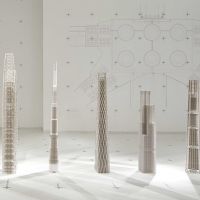 Caitlin Mueller moderates panel discussion at Chicago Architecture Biennial2017-11-28, Tags: collaboration art engineering
Caitlin Mueller moderates panel discussion at Chicago Architecture Biennial2017-11-28, Tags: collaboration art engineeringAs part of SOM: Engineering x [Art + Architecture], an exhibition produced by Mana Contemporary Chicago in partnership with the Chicago Architecture Biennial, Caitlin Mueller led a panel discussion focused on collaborations between artists and structural engineers. Panelists include renowned artists and SOM collaborators Iñigo Manglano-Ovalle and Janet Echelman, and SOM Structural Engineers William F. Baker, Alessandro Beghini, and Nicole Wang.
Caitlin Mueller moderates panel discussion at Chicago Architecture Biennial
2017-11-28
As part of SOM: Engineering x [Art + Architecture], an exhibition produced by Mana Contemporary Chicago in partnership with the Chicago Architecture Biennial, Caitlin Mueller led a panel discussion focused on collaborations between artists and structural engineers. Panelists include renowned artists and SOM collaborators Iñigo Manglano-Ovalle and Janet Echelman, and SOM Structural Engineers William F. Baker, Alessandro Beghini, and Nicole Wang.
Related group members:
Tags:

-
 Caitlin Mueller to join panel for C3E Women in Clean Energy Symposium2017-11-14, Tags: embodied-carbon energy
Caitlin Mueller to join panel for C3E Women in Clean Energy Symposium2017-11-14, Tags: embodied-carbon energyAs part of the 2017 C3E Women in Clean Energy Symposium, Caitlin Mueller will join a panel discussion focused on enabling technologies for a clean energy future on Wednesday, November 15.
Caitlin Mueller to join panel for C3E Women in Clean Energy Symposium
2017-11-14
As part of the 2017 C3E Women in Clean Energy Symposium, Caitlin Mueller will join a panel discussion focused on enabling technologies for a clean energy future on Wednesday, November 15.
Tags:

-
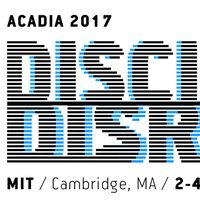 Caitlin Mueller and Nathan Brown at ACADIA 2017 at MIT2017-11-03, Tags: computation
Caitlin Mueller and Nathan Brown at ACADIA 2017 at MIT2017-11-03, Tags: computationMIT is hosting the 2017 ACADIA conference with participation from Digital Structures members. Caitlin Mueller is the Papers Co-Chair for the conference, and Nathan Brown is presenting a paper on data-driven computational design. The conference has attracted a record number of participants, including several Digital Structures alums.
Caitlin Mueller and Nathan Brown at ACADIA 2017 at MIT
2017-11-03
MIT is hosting the 2017 ACADIA conference with participation from Digital Structures members. Caitlin Mueller is the Papers Co-Chair for the conference, and Nathan Brown is presenting a paper on data-driven computational design. The conference has attracted a record number of participants, including several Digital Structures alums.
Related publications:
Related group members:
Tags:

-
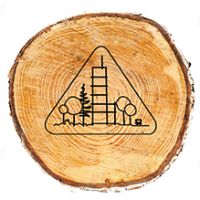 Paul Mayencourt presents at Wood at Work Montreal2017-10-27, Tags: computation fabrication digital-manufacturing embodied-carbon structural-optimization timber
Paul Mayencourt presents at Wood at Work Montreal2017-10-27, Tags: computation fabrication digital-manufacturing embodied-carbon structural-optimization timberPaul Mayencourt presented research on opportunities for using structural optimization and digital fabrication to shape wood structural beams and building components at the third annual Wood at Work conference in Montreal.
Paul Mayencourt presents at Wood at Work Montreal
2017-10-27
Paul Mayencourt presented research on opportunities for using structural optimization and digital fabrication to shape wood structural beams and building components at the third annual Wood at Work conference in Montreal.
Related group members:
Tags:
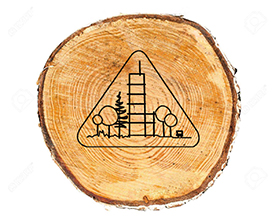
-
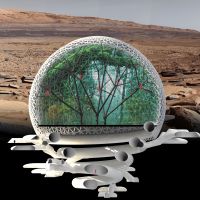 Valentina Sumini and team win First Place in Mars City Design 2017 Competition for Urban Design2017-10-19, Tags: computation fabrication Mars city computational-design
Valentina Sumini and team win First Place in Mars City Design 2017 Competition for Urban Design2017-10-19, Tags: computation fabrication Mars city computational-designTogether with an interdisciplinary team of MIT students, Valentina Sumini was awarded First Place in a design competition for a future city on Mars. The winning design concept, called Redwood Forest, incorporates inflated biospheres and tree structures anchored into the ground with a root-system-like network of tunnels. For more information, see this article from Slice of MIT and this one from MIT News.
Valentina Sumini and team win First Place in Mars City Design 2017 Competition for Urban Design
2017-10-19
Together with an interdisciplinary team of MIT students, Valentina Sumini was awarded First Place in a design competition for a future city on Mars. The winning design concept, called Redwood Forest, incorporates inflated biospheres and tree structures anchored into the ground with a root-system-like network of tunnels. For more information, see this article from Slice of MIT and this one from MIT News.
Related group members:
Tags:

-
 Digital Structures heads to Hamburg for IASS 20172017-09-24, Tags: iass
Digital Structures heads to Hamburg for IASS 20172017-09-24, Tags: iassCaitlin Mueller, Nate Brown, and Paul Mayencourt are in Germany this week for the 2017 IASS Symposium, presenting several papers and catching up with friends and colleagues from the IASS community.
Digital Structures heads to Hamburg for IASS 2017
2017-09-24
Caitlin Mueller, Nate Brown, and Paul Mayencourt are in Germany this week for the 2017 IASS Symposium, presenting several papers and catching up with friends and colleagues from the IASS community.
Related group members:
Related blog posts:
Tags:
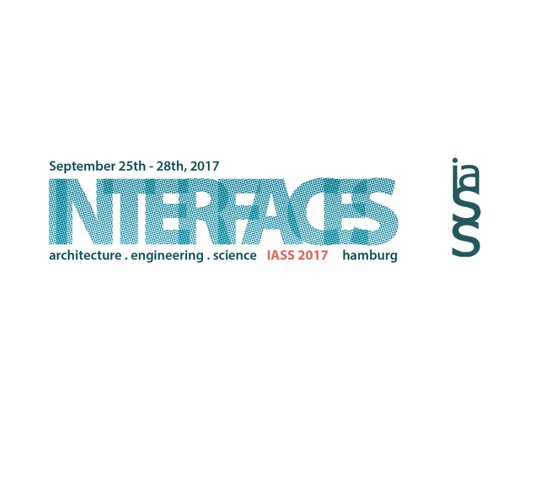
-
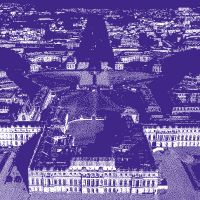 Caitlin Mueller and Renaud Danhaive at Design Modelling Symposium Paris2017-09-18
Caitlin Mueller and Renaud Danhaive at Design Modelling Symposium Paris2017-09-18Professor Mueller delivers a keynote address and Renaud Danhaive presents a research paper at the Design Modelling Symposium in Versailles.
Caitlin Mueller and Renaud Danhaive at Design Modelling Symposium Paris
2017-09-18
Professor Mueller delivers a keynote address and Renaud Danhaive presents a research paper at the Design Modelling Symposium in Versailles.
Related group members:

-
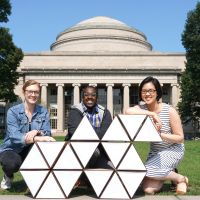 Welcome new Digital Structures students2017-09-13
Welcome new Digital Structures students2017-09-13This school year we welcome three new graduate students to Digital Structures (left to right): Courtney Stephen, Mohamed "Moh" Ismail, and Demi Fang. Courtney is working on a FEMA grant focused on post-disaster housing. As a Tata Fellow, Moh will explore sustainable structural components in the developing world. Demi hopes to work on the parametric design of interlocking joint connections.
Welcome new Digital Structures students
2017-09-13
This school year we welcome three new graduate students to Digital Structures (left to right): Courtney Stephen, Mohamed "Moh" Ismail, and Demi Fang. Courtney is working on a FEMA grant focused on post-disaster housing. As a Tata Fellow, Moh will explore sustainable structural components in the developing world. Demi hopes to work on the parametric design of interlocking joint connections.
Related group members:

-
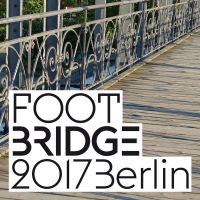 Paul Mayencourt presents at Footbridge 2017 Berlin2017-09-04
Paul Mayencourt presents at Footbridge 2017 Berlin2017-09-04Ph.D. student Paul Mayencourt presented a conceptual design for a pedestrian bridge in Berlin designed by a group of Digital Structures students at the Footbridge 2017 conference. Called Hängemattenbrücke, the design uses a tree-like cable topology and a curved deck to create an urban resting place in the city.
Paul Mayencourt presents at Footbridge 2017 Berlin
2017-09-04
Ph.D. student Paul Mayencourt presented a conceptual design for a pedestrian bridge in Berlin designed by a group of Digital Structures students at the Footbridge 2017 conference. Called Hängemattenbrücke, the design uses a tree-like cable topology and a curved deck to create an urban resting place in the city.
Related projects:
Related group members:

-
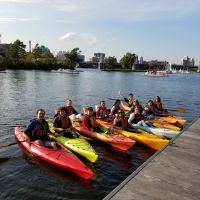 Digital Structures celebrates the end of summer2017-08-31
Digital Structures celebrates the end of summer2017-08-31Our group took advantage of the beautiful August weather with a kayaking trip on the Charles River.
-
 Caitlin Mueller and Yijiang Huang lead parametric design workshop at Tsinghua University Summer School2017-07-31
Caitlin Mueller and Yijiang Huang lead parametric design workshop at Tsinghua University Summer School2017-07-31Caitlin and Yijiang spent 8 days in Beijing teaching a group of students about parametric design, structural optimization, and digital fabrication at the Tsinghua University School of Architecture. Working in teams, students designed and built four bridges that span 2.4 meters and support the weight of the students. The students used tools developed by Digital Structures to create an impressive variety of design possibilities.
Caitlin Mueller and Yijiang Huang lead parametric design workshop at Tsinghua University Summer School
2017-07-31
Caitlin and Yijiang spent 8 days in Beijing teaching a group of students about parametric design, structural optimization, and digital fabrication at the Tsinghua University School of Architecture. Working in teams, students designed and built four bridges that span 2.4 meters and support the weight of the students. The students used tools developed by Digital Structures to create an impressive variety of design possibilities.
Related projects:
Related group members:

-
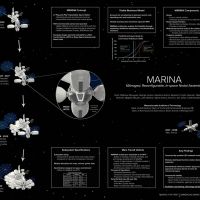 MIT space hotel wins NASA graduate design competition2017-06-28, Tags: collaboration computation mars space
MIT space hotel wins NASA graduate design competition2017-06-28, Tags: collaboration computation mars spaceAn interdisciplinary project including several members of Digital Structures won first place at the graduate division of NASA’s Revolutionary Aerospace Systems Concepts - Academic Linkage Design Competition Forum 2017. For more information, click here.
The LEO project is a new commercial space station that would ensure continued development of the commercial launch market after ISS will be decommissioned by 2028. This station could lead to the emergence of new commercial space activities and markets at permanent destinations in LEO and cislunar space. The commercial station would also foster the emergence of novel space-based industries that would in turn provide NASA with improved technology development at reduced cost.
The MAnaged, Reconfigurable, In-space Nodal Assembly (MARINA) commercial space station concept is a modular LEO station that lowers the barrier to entry for commercial activity in space. It will be in a 400km, 51° orbit. Its backbone is made of nodes that provide radially adjacent customer modules with structural connections and common interfaces for utilities, such as power, water, air, and thermal control. Large companies or space agencies can launch customer modules and pay rent to dock them to the station’s nodes. In the design, 4 different configurations are considered according to the actual demand.
MIT space hotel wins NASA graduate design competition
2017-06-28
An interdisciplinary project including several members of Digital Structures won first place at the graduate division of NASA’s Revolutionary Aerospace Systems Concepts - Academic Linkage Design Competition Forum 2017. For more information, click here.
The LEO project is a new commercial space station that would ensure continued development of the commercial launch market after ISS will be decommissioned by 2028. This station could lead to the emergence of new commercial space activities and markets at permanent destinations in LEO and cislunar space. The commercial station would also foster the emergence of novel space-based industries that would in turn provide NASA with improved technology development at reduced cost.
The MAnaged, Reconfigurable, In-space Nodal Assembly (MARINA) commercial space station concept is a modular LEO station that lowers the barrier to entry for commercial activity in space. It will be in a 400km, 51° orbit. Its backbone is made of nodes that provide radially adjacent customer modules with structural connections and common interfaces for utilities, such as power, water, air, and thermal control. Large companies or space agencies can launch customer modules and pay rent to dock them to the station’s nodes. In the design, 4 different configurations are considered according to the actual demand.
Related group members:
Tags:

-
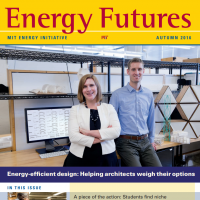 Caitlin Mueller and Nathan Brown featured on cover of Energy Futures magazine2016-09-01, Tags: computation multi-objective-optimization energy
Caitlin Mueller and Nathan Brown featured on cover of Energy Futures magazine2016-09-01, Tags: computation multi-objective-optimization energyEnergy Futures featured Caitlin and Nate on the cover of their Autumn 2016 issue, along with an article about their work on multi-objective optimization for building energy performance in conceptual design. The full article can be read here.
Caitlin Mueller and Nathan Brown featured on cover of Energy Futures magazine
2016-09-01
Energy Futures featured Caitlin and Nate on the cover of their Autumn 2016 issue, along with an article about their work on multi-objective optimization for building energy performance in conceptual design. The full article can be read here.
Related projects:
Related publications:
Related group members:
Tags:

-
 Caitlin Mueller gives invited talk about 3D printed structures at 50th SEAoA Convention2016-06-17
Caitlin Mueller gives invited talk about 3D printed structures at 50th SEAoA Convention2016-06-17In a talk entitled 3D Printed Structures: Challenges and Opportunities, Caitlin Mueller spoke to practicing structural engineers above current developments and future research directions in the area of full-scale 3D printing technologies for buildings and bridges.
Caitlin Mueller gives invited talk about 3D printed structures at 50th SEAoA Convention
2016-06-17
In a talk entitled 3D Printed Structures: Challenges and Opportunities, Caitlin Mueller spoke to practicing structural engineers above current developments and future research directions in the area of full-scale 3D printing technologies for buildings and bridges.
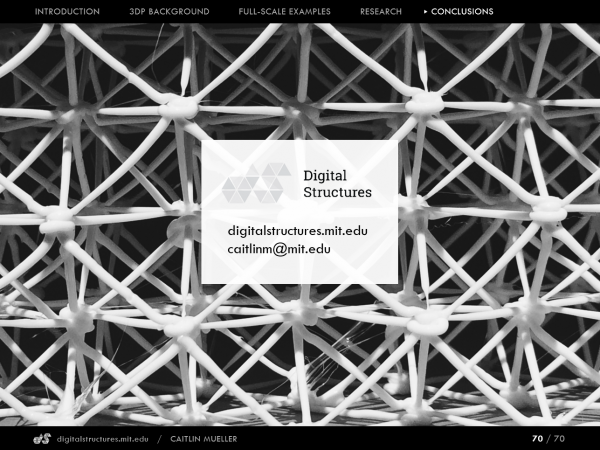
-
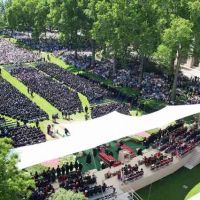 Congratulations to our 2016 Digital Structures MIT graduates2016-06-03
Congratulations to our 2016 Digital Structures MIT graduates2016-06-03Undergraduate Chyrstal Chern and graduate students Inés Ariza, Nate Brown, Jessica Duke, Ben Jacot, and Melody Tan all received MIT degrees today. Congratulations to them and the rest of the Class of 2016!
Congratulations to our 2016 Digital Structures MIT graduates
2016-06-03
Undergraduate Chyrstal Chern and graduate students Inés Ariza, Nate Brown, Jessica Duke, Ben Jacot, and Melody Tan all received MIT degrees today. Congratulations to them and the rest of the Class of 2016!
Related group members:

-
 4.101 Final review: Undergraduates design and build full-scale spanning structures2016-05-12
4.101 Final review: Undergraduates design and build full-scale spanning structures2016-05-12The large-scale structures were designed and fabricated by students working in teams of three over the final five weeks of the class. One structure featured an array of articulating, tesselating tetrahedral forms made with polycarbonate tubes and custom-designed lasercut snap fit joints. The second structure, a pair of segmented towers made of hand-cut foam blocks, could be converted from stiff, straight forms to flexible, expressive tentacles by changing the tension in the design's integrated elastic chords.
4.101 Final review: Undergraduates design and build full-scale spanning structures
2016-05-12
The large-scale structures were designed and fabricated by students working in teams of three over the final five weeks of the class. One structure featured an array of articulating, tesselating tetrahedral forms made with polycarbonate tubes and custom-designed lasercut snap fit joints. The second structure, a pair of segmented towers made of hand-cut foam blocks, could be converted from stiff, straight forms to flexible, expressive tentacles by changing the tension in the design's integrated elastic chords.

-
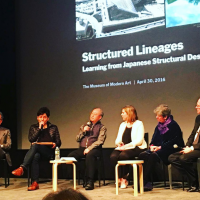 Caitlin Mueller takes part in Structured Lineages: Learning from Japanese Structural Design at MoMA2016-04-30
Caitlin Mueller takes part in Structured Lineages: Learning from Japanese Structural Design at MoMA2016-04-30Organized by Guy Nordenson of Princeton with John Ochsendorf of MIT at the Museum of Modern Art in New York, the event featured presentations from many leading structural engineers from around the world. Cailtin moderated a panel featuring Mutsuro Sasaki, Bill Baker, Jane Wernick, and Guy Nordenson. Photo from Chikara Inamura.
Caitlin Mueller takes part in Structured Lineages: Learning from Japanese Structural Design at MoMA
2016-04-30
Organized by Guy Nordenson of Princeton with John Ochsendorf of MIT at the Museum of Modern Art in New York, the event featured presentations from many leading structural engineers from around the world. Cailtin moderated a panel featuring Mutsuro Sasaki, Bill Baker, Jane Wernick, and Guy Nordenson. Photo from Chikara Inamura.

-
 MIT Architecture + CEE host Symposium on Creativity in Engineering Design2016-04-29
MIT Architecture + CEE host Symposium on Creativity in Engineering Design2016-04-29Featuring presentations by Laurent Ney, Mike Schlaich, and Sheila Kennedy, the symposium focused on creativity and collaboration in architecture and structural engineering. Caitlin Mueller moderated a panel discussion following the presentations.
MIT Architecture + CEE host Symposium on Creativity in Engineering Design
2016-04-29
Featuring presentations by Laurent Ney, Mike Schlaich, and Sheila Kennedy, the symposium focused on creativity and collaboration in architecture and structural engineering. Caitlin Mueller moderated a panel discussion following the presentations.

-
 Jane Wernick delivers 10th Goldstein Lecture in Art, Engineering, and Science2016-04-11
Jane Wernick delivers 10th Goldstein Lecture in Art, Engineering, and Science2016-04-11Structural engineer and author Jane Wernick came to MIT to speak about her approach to structural design, collaboration with architects, and creativity. She shared many of her exciting projects from her time at Arup and Jane Wernick Assocates, including her early collaborations with Zaha Hadid and her work on the London Eye.
Jane Wernick delivers 10th Goldstein Lecture in Art, Engineering, and Science
2016-04-11
Structural engineer and author Jane Wernick came to MIT to speak about her approach to structural design, collaboration with architects, and creativity. She shared many of her exciting projects from her time at Arup and Jane Wernick Assocates, including her early collaborations with Zaha Hadid and her work on the London Eye.

-
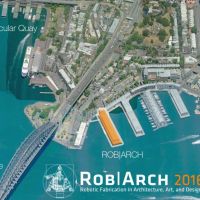 Mark Tam and Caitlin Mueller present at RobArch 2016 in Sydney2016-03-18, Tags: fabrication 3d-printing additive-manufacturing principal-stress-lines
Mark Tam and Caitlin Mueller present at RobArch 2016 in Sydney2016-03-18, Tags: fabrication 3d-printing additive-manufacturing principal-stress-linesDigital Structures are at the 3rd Robotics in Architecture conference in Sydney, Australia to share their work on robotics-enabled stress line additive manufacturing, a new 3D printing technique that deposits material along lines of force flow for enhanced structural performance.
Mark Tam and Caitlin Mueller present at RobArch 2016 in Sydney
2016-03-18
Digital Structures are at the 3rd Robotics in Architecture conference in Sydney, Australia to share their work on robotics-enabled stress line additive manufacturing, a new 3D printing technique that deposits material along lines of force flow for enhanced structural performance.
Related projects:
Related publications:
Related group members:
Tags:

-
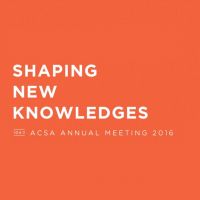 Renaud Danhaive presents at the 104th ACSA Annual Meeting in Seattle2016-03-18, Tags: collaboration computation conceptual-structural-design computational-design
Renaud Danhaive presents at the 104th ACSA Annual Meeting in Seattle2016-03-18, Tags: collaboration computation conceptual-structural-design computational-designIn a session titled Structure as Design Knowledge, Renaud presents a paper that connects the history of computation in architecture and structural engineering to current and future digital developments.
Renaud Danhaive presents at the 104th ACSA Annual Meeting in Seattle
2016-03-18
In a session titled Structure as Design Knowledge, Renaud presents a paper that connects the history of computation in architecture and structural engineering to current and future digital developments.
Related group members:
Tags:

-
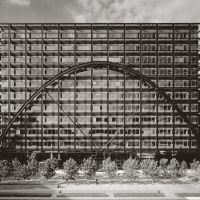 Nate Brown wins 2016 SOM Structural Engineering Travelling Fellowship2016-03-04
Nate Brown wins 2016 SOM Structural Engineering Travelling Fellowship2016-03-04Congratulations to Digital Structures graduate student Nate Brown for winning this prestigious fellowship. His travel itinerary, described in detail here, will focus on buildings that synthesize multiple design goals simultaneously, a theme that extends from his research in multiobjective optimization for design. For further information, see this MIT News article.
Nate Brown wins 2016 SOM Structural Engineering Travelling Fellowship
2016-03-04
Congratulations to Digital Structures graduate student Nate Brown for winning this prestigious fellowship. His travel itinerary, described in detail here, will focus on buildings that synthesize multiple design goals simultaneously, a theme that extends from his research in multiobjective optimization for design. For further information, see this MIT News article.
Related group members:

-
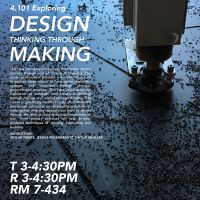 New design making class at MIT for undergraduates: 4.1012016-02-02, Tags: computation fabrication making design
New design making class at MIT for undergraduates: 4.1012016-02-02, Tags: computation fabrication making designCaitlin Mueller is teaching an exciting new class with Skylar Tibbits (MIT Self Assembly Lab) and Jessica Rosenkrantz (Nervous System). Full title is Exploring Design: Thinking through Making. Description as follows: Introduces the creative design process through acts of making. Studio environment provides a dynamic laboratory to explore ideas related to form, space, materials, systems, and structures through physical, project-based activities. Emphasizes the translation of concepts into constructs--thinking through making, and making through thinking. Taught by faculty across art, design, architecture and technology disciplines, the class exposes students to a unique cross-section of design inquiry.
New design making class at MIT for undergraduates: 4.101
2016-02-02
Caitlin Mueller is teaching an exciting new class with Skylar Tibbits (MIT Self Assembly Lab) and Jessica Rosenkrantz (Nervous System). Full title is Exploring Design: Thinking through Making. Description as follows: Introduces the creative design process through acts of making. Studio environment provides a dynamic laboratory to explore ideas related to form, space, materials, systems, and structures through physical, project-based activities. Emphasizes the translation of concepts into constructs--thinking through making, and making through thinking. Taught by faculty across art, design, architecture and technology disciplines, the class exposes students to a unique cross-section of design inquiry.
Tags:

-
 Zhao Ma and Yu Zhang win Design Driven Innovation Hackathon2016-02-01, Tags: computation
Zhao Ma and Yu Zhang win Design Driven Innovation Hackathon2016-02-01, Tags: computationCongratulations to Zhao and Yu for winning the weekend-long Make Me++ hackathon of the 2016 Design Drive Innovation conference at the MIT Media Lab.
Zhao Ma and Yu Zhang win Design Driven Innovation Hackathon
2016-02-01
Congratulations to Zhao and Yu for winning the weekend-long Make Me++ hackathon of the 2016 Design Drive Innovation conference at the MIT Media Lab.
Related group members:
Tags:

-
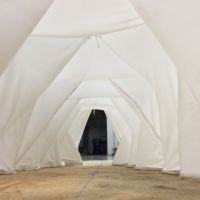 Winnipeg Warming Hut ice shell collaboration with University of Manitoba2016-01-19, Tags: computation fabrication ice-shells
Winnipeg Warming Hut ice shell collaboration with University of Manitoba2016-01-19, Tags: computation fabrication ice-shellsCaitlin Mueller spent a week in Winnipeg, Canada working with a team from the University of Manitoba's Faculty of Architecture, led by Lancelot Coar, Kim Wiese, and Jason Hare, on a large-scale origami-inspired fabric and ice shell. Called Fabrigami, the installation is part of the Winnipeg Warming Huts competition, and combines folded plate morphology with the curvatures of fabric-formed ice.
Winnipeg Warming Hut ice shell collaboration with University of Manitoba
2016-01-19
Caitlin Mueller spent a week in Winnipeg, Canada working with a team from the University of Manitoba's Faculty of Architecture, led by Lancelot Coar, Kim Wiese, and Jason Hare, on a large-scale origami-inspired fabric and ice shell. Called Fabrigami, the installation is part of the Winnipeg Warming Huts competition, and combines folded plate morphology with the curvatures of fabric-formed ice.
Tags:

-
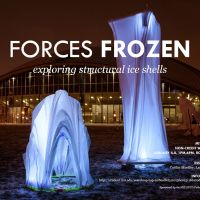 Forces Frozen workshop at MIT starts today!2016-01-04, Tags: fabrication
Forces Frozen workshop at MIT starts today!2016-01-04, Tags: fabricationThe third installment of this IAP (Independent Activities Period, i.e. January at MIT) workshop includes 20 students from both MIT and SUTD. Due to warmer than normal temperatures, this year's workshop will include explorations in both ice (outdoors) and wax (indoors). This year's version is co-taught by the University of Manitoba's Professor Lancelot Coar! Thanks to the MIT-SUTD Collaboration Office for sponsoring the workshop.
Forces Frozen workshop at MIT starts today!
2016-01-04
The third installment of this IAP (Independent Activities Period, i.e. January at MIT) workshop includes 20 students from both MIT and SUTD. Due to warmer than normal temperatures, this year's workshop will include explorations in both ice (outdoors) and wax (indoors). This year's version is co-taught by the University of Manitoba's Professor Lancelot Coar! Thanks to the MIT-SUTD Collaboration Office for sponsoring the workshop.
Related projects:
Tags:

-
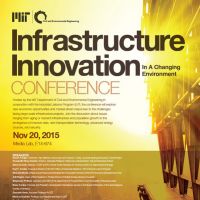 Digital Structures presentation at Infrastructure Innovation Conference at MIT2015-11-20
Digital Structures presentation at Infrastructure Innovation Conference at MIT2015-11-20Caitlin Mueller presented work on data-driven design for sustainability and constructability at a conference at MIT hosted by the Department of Civil and Environmental Engineering and the Industrial Liason Program entitled Infrastructure Innovation in a Changing Environment.
Digital Structures presentation at Infrastructure Innovation Conference at MIT
2015-11-20
Caitlin Mueller presented work on data-driven design for sustainability and constructability at a conference at MIT hosted by the Department of Civil and Environmental Engineering and the Industrial Liason Program entitled Infrastructure Innovation in a Changing Environment.
Related group members:

-
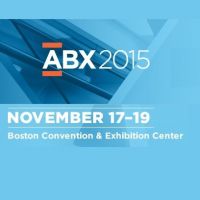 Boston Society of Architects' ABX conference includes presentation from Digital Structures2015-11-18, Tags: collaboration computation
Boston Society of Architects' ABX conference includes presentation from Digital Structures2015-11-18, Tags: collaboration computationBoston Society of Architects' ABX conference includes presentation from Digital Structures
2015-11-18
Caitlin Mueller, Nathan Brown, and Renaud Danhaive spoke about new digital tools for creative and performance-driven conceptual design at the ABX 2015 conference in Boston this week as part of the Women In Design Symposium. More details about the talk here.
Related projects:
Related publications:
Related group members:
Tags:
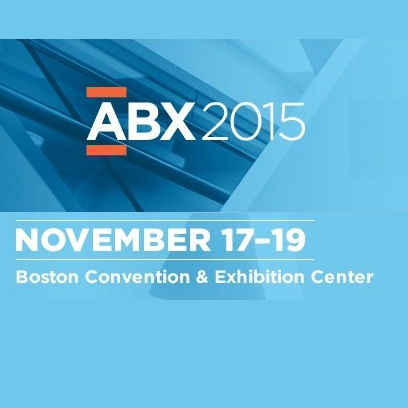
-
 Mueller to speak in MIT's CEE Pierce Lab Seminar Series2015-10-28
Mueller to speak in MIT's CEE Pierce Lab Seminar Series2015-10-28Caitlin Mueller is giving a talk on recent research work, entitled Digital Design and Fabrication of Tomorrow's Innovative Structures, as part of the Pierce Lab Seminar Series in Mechanics and Infrastructure at MIT.
Mueller to speak in MIT's CEE Pierce Lab Seminar Series
2015-10-28
Caitlin Mueller is giving a talk on recent research work, entitled Digital Design and Fabrication of Tomorrow's Innovative Structures, as part of the Pierce Lab Seminar Series in Mechanics and Infrastructure at MIT.

-
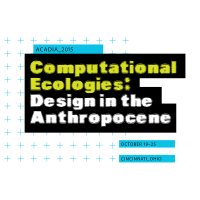 Digital Structures presents work at ACADIA 2015 in Cincinnati2015-10-27, Tags: computation principal-stress-lines
Digital Structures presents work at ACADIA 2015 in Cincinnati2015-10-27, Tags: computation principal-stress-linesCaitlin Mueller attended the 2015 ACADIA conference to share her and Mark Tam's work on generating materializable stress lines for architectural design.
Digital Structures presents work at ACADIA 2015 in Cincinnati
2015-10-27
Caitlin Mueller attended the 2015 ACADIA conference to share her and Mark Tam's work on generating materializable stress lines for architectural design.
Related projects:
Related publications:
Related group members:
Tags:

-
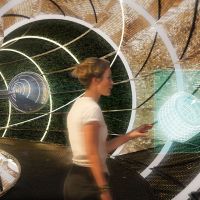 Interplanetary Architecture article and video feature Ouroboros Martian Habitat2015-10-15, Tags: mars 3d-printing
Interplanetary Architecture article and video feature Ouroboros Martian Habitat2015-10-15, Tags: mars 3d-printingA recent MIT News article discussed the Digital Structures' Villa Ouroboros proposal for additively manufactured habitats on Mars. An accompanying video that shows more of the team's proposal is also included.
Interplanetary Architecture article and video feature Ouroboros Martian Habitat
2015-10-15
A recent MIT News article discussed the Digital Structures' Villa Ouroboros proposal for additively manufactured habitats on Mars. An accompanying video that shows more of the team's proposal is also included.
Related projects:
Related group members:
Tags:

-
 MIT News article features Un-flat Inevitabilities studio2015-10-08
MIT News article features Un-flat Inevitabilities studio2015-10-08This MIT News story discusses the new cross-studio initiative at the MIT Department of Architecture, a program that develops new options-level design studios for Master of Architecture students with interdisciplinary themes. The Un-flat Inevitabilities studio, taught by Caitlin Mueller and Joel Lamere, explored opportunities and contradictions at the intersection of architectural geometry and structural performance.
MIT News article features Un-flat Inevitabilities studio
2015-10-08
This MIT News story discusses the new cross-studio initiative at the MIT Department of Architecture, a program that develops new options-level design studios for Master of Architecture students with interdisciplinary themes. The Un-flat Inevitabilities studio, taught by Caitlin Mueller and Joel Lamere, explored opportunities and contradictions at the intersection of architectural geometry and structural performance.
Related projects:
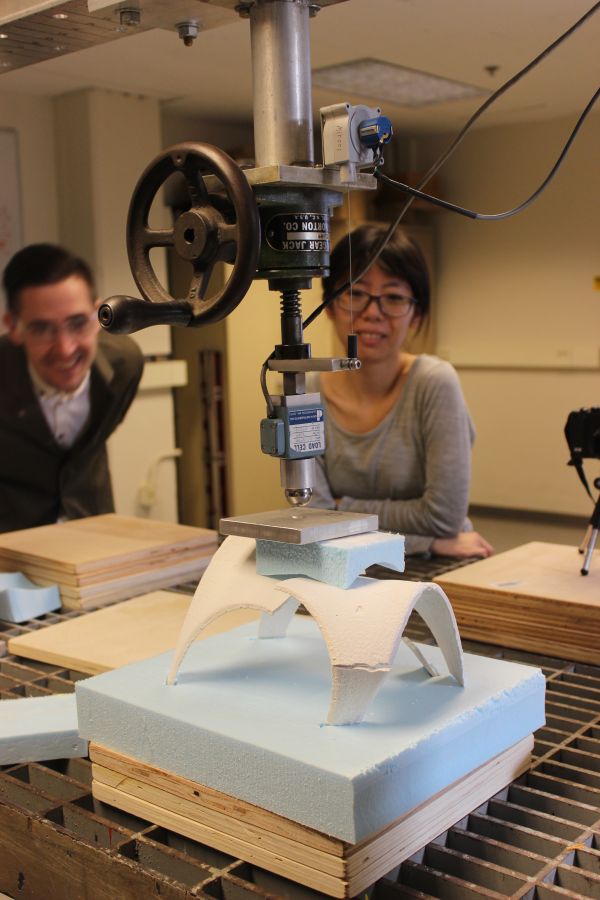
-
 Juney Lee and Sayjel Patel present at the Design Modelling Symposium in Copenhagen2015-10-05, Tags: computation
Juney Lee and Sayjel Patel present at the Design Modelling Symposium in Copenhagen2015-10-05, Tags: computationJuney Lee and Sayjel Patel participated in the Design Modelling Symposium in Copenhagen last week, presenting their Digital Structures research on graphic statics-based structural grammars and performative texture sampling, respectively.
Juney Lee and Sayjel Patel present at the Design Modelling Symposium in Copenhagen
2015-10-05
Juney Lee and Sayjel Patel participated in the Design Modelling Symposium in Copenhagen last week, presenting their Digital Structures research on graphic statics-based structural grammars and performative texture sampling, respectively.
Related projects:
Related publications:
Related group members:
Tags:

-
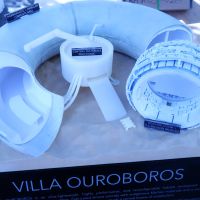 Digital Structures heads to World Maker Faire in NYC2015-09-25, Tags: fabrication 3d-printing additive-manufacturing mars composites
Digital Structures heads to World Maker Faire in NYC2015-09-25, Tags: fabrication 3d-printing additive-manufacturing mars compositesMitchell Gu, Caitlin Mueller, and team head to NYC as finalists in the NASA 3D Printed Habitat Challenge at the World Maker Faire. Our submission includes a 3D-printed model that makes use of four different additive manufacturing strategies, including a heat-formed thermoplastic composite shell.
Digital Structures heads to World Maker Faire in NYC
2015-09-25
Mitchell Gu, Caitlin Mueller, and team head to NYC as finalists in the NASA 3D Printed Habitat Challenge at the World Maker Faire. Our submission includes a 3D-printed model that makes use of four different additive manufacturing strategies, including a heat-formed thermoplastic composite shell.
Related projects:
Related group members:
Tags:

-
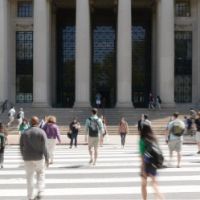 Two Digital Structures classes offered this term at MIT2015-09-09
Two Digital Structures classes offered this term at MIT2015-09-09The academic year begins this week, with two courses offered by Caitlin Mueller in the Department of Architecture: 4.463 Building Structural Systems II (with Andrea Love, Les Norford, and Nathan Brown (TA) and linked the the Core III MArch studio) and 4.450 Computational Structural Design and Optimization.
Two Digital Structures classes offered this term at MIT
2015-09-09
The academic year begins this week, with two courses offered by Caitlin Mueller in the Department of Architecture: 4.463 Building Structural Systems II (with Andrea Love, Les Norford, and Nathan Brown (TA) and linked the the Core III MArch studio) and 4.450 Computational Structural Design and Optimization.
Related projects:
Related group members:
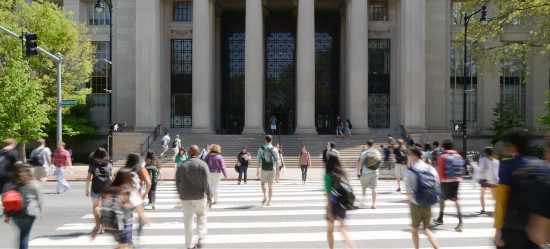
-
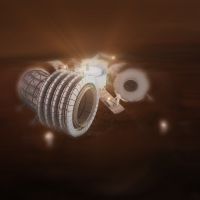 Digital Structures Finalists in NASA's 3D-Printed Habitat Challenge2015-09-01, Tags: fabrication additive-manufacturing space-architecture mars composites
Digital Structures Finalists in NASA's 3D-Printed Habitat Challenge2015-09-01, Tags: fabrication additive-manufacturing space-architecture mars compositesAn interdisciplinary team of Digital Structures students, along with Justin Lavallee of the Architecture Fab Lab, are finalists in a NASA competition to design 3D-printed habitats for a 2035 Mars mission. Our submision will be presented at the World Maker Faire in New York on Sept. 26-27. More information about our design concept, called Ouroboros, and fabrication processes can be found here.
Digital Structures Finalists in NASA's 3D-Printed Habitat Challenge
2015-09-01
An interdisciplinary team of Digital Structures students, along with Justin Lavallee of the Architecture Fab Lab, are finalists in a NASA competition to design 3D-printed habitats for a 2035 Mars mission. Our submision will be presented at the World Maker Faire in New York on Sept. 26-27. More information about our design concept, called Ouroboros, and fabrication processes can be found here.
Related projects:
Related group members:
Tags:

-
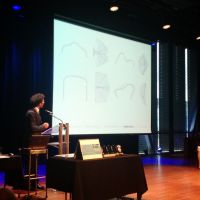 Leonardo Todisco wins IASS's Hangai Prize for young researchers2015-08-20, Tags: computation
Leonardo Todisco wins IASS's Hangai Prize for young researchers2015-08-20, Tags: computationLeonardo Todisco was awarded the Hangai Prize for his work on funicular post-tensioning, which he developed while at MIT in the Digital Structures group. Congratulations, Leo!
Leonardo Todisco wins IASS's Hangai Prize for young researchers
2015-08-20
Leonardo Todisco was awarded the Hangai Prize for his work on funicular post-tensioning, which he developed while at MIT in the Digital Structures group. Congratulations, Leo!
Related projects:
Related publications:
Related group members:
Tags:

-
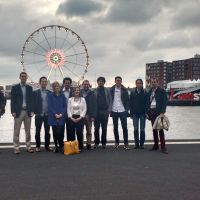 Digital Structures goes to IASS Symposium in Amsterdam2015-08-18, Tags: computation fabrication
Digital Structures goes to IASS Symposium in Amsterdam2015-08-18, Tags: computation fabricationThe group presented six papers at the annual symposium of the International Association of Shell and Spatial Structures in Amsterdam, along with the Paperwave pavilion.
Digital Structures goes to IASS Symposium in Amsterdam
2015-08-18
The group presented six papers at the annual symposium of the International Association of Shell and Spatial Structures in Amsterdam, along with the Paperwave pavilion.
Related projects:
Related publications:
Related group members:
Tags:

-
 Our new website is live!2015-08-01
Our new website is live!2015-08-01A year after its inception, the Digital Structures research group has its new website up at digitalstructures.mit.edu. Welcome!
join us
Interested in joining Digital Structures or contributing to our work? We are a collaborative, multi-disciplinary team seeking members who are open-minded, forward-looking, technically excellent, and excited about our research mission. In particular, architects oriented toward technology and engineers oriented toward creative design are good fits for our group, along with those who have dual backgrounds in architecture and engineering.
MIT undergraduates
We involve undergraduate students at MIT through the UROP program for fall, spring, and summer terms. We sometimes post specific positions on the Current Openings page, but we also take students for projects that are not posted. If you'd like to work with us but don't see a specific open position, look through our current projects and to Professor Mueller with a brief statement about your background and which projects you're especially interested in.
graduate students
Potential graduate students interested in joining the group should apply to one of several degree programs at MIT. Within Architecture, students can apply to the SMBT, SMArchS, or PhD degrees in the Building Technology Program, depending on their backgrounds and interests. Within Civil and Environmental Engineering, most students should apply to the MEng program. Our group also involves students in the Computation for Design and Optimization program. If you are thinking about applying, it is highly recommended that you Professor Mueller to discuss which program(s) would be the best fit for you.
visitors
Outside of MIT undergraduate and graduate students, we also involve a very limited number of visiting researchers, who are generally graduate students at other universities funded through external programs. If you are interested in visiting, Professor Mueller with details about your background, the program you would visit through, and why you are interested in joining the group.
collaborators
We are always interested in potential collaborations with other research groups, especially those with thematic overlap and complementary expertise. Please if we'd be a good fit for one of your projects or if you'd like to contribute to one of ours.
contact
Digital Structures can be reached via email through Professor Mueller at . Administrative inquiries can also be directed to Kathleen Ross, Assistant to the Building Technology Program, at .
Directions within the MIT Campus
From Lobby 7, inside the main MIT entrance at 77 Massachusetts Avenue, take the rear left elevator to the 4th floor. Make two right turns (in other words, walk 135 degrees clockwise around the dome), and turn left. Walk toward the green wall with the "Building Technology Program" sign and make another left. The door to 5-418 is on the left.
Mailing Address
Digital Structures
77 Massachusetts Avenue
MIT Room 5-418, Attn: Caitlin Mueller
Cambridge, MA 02139
United States


